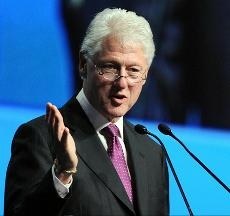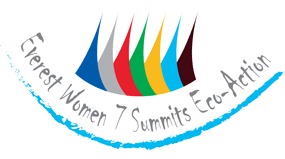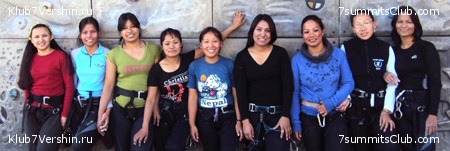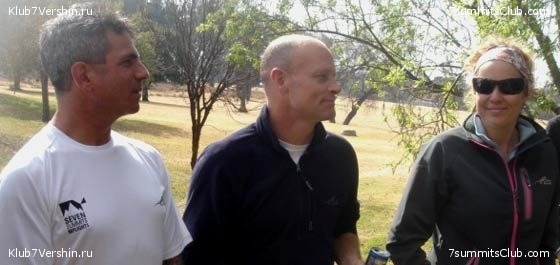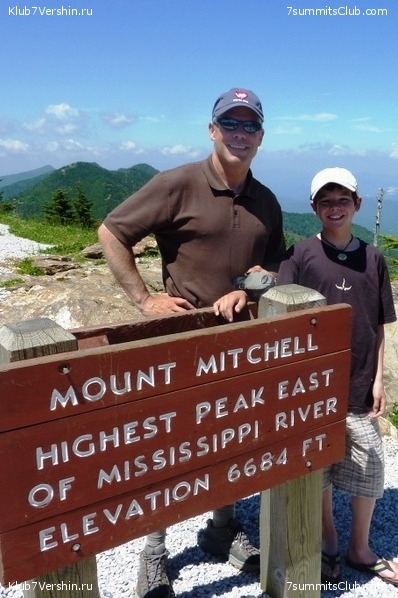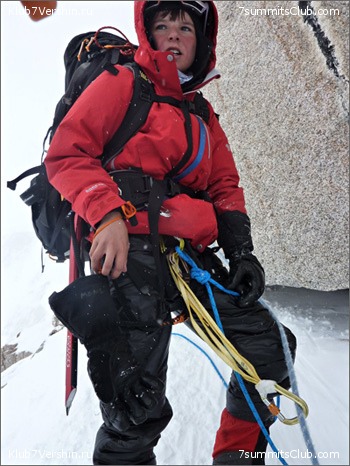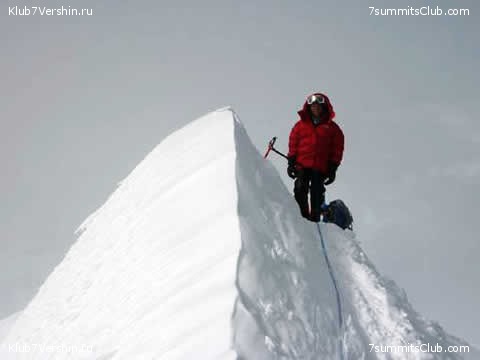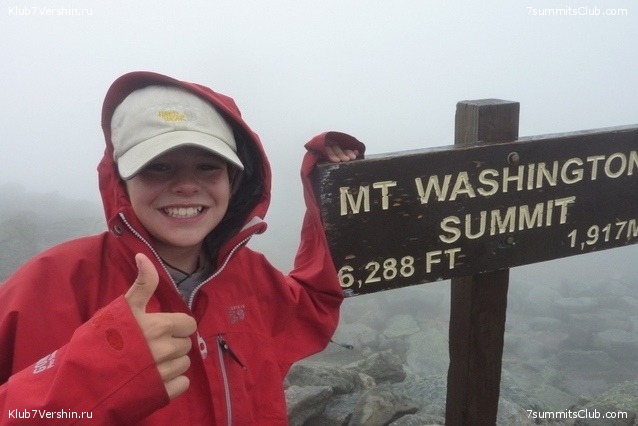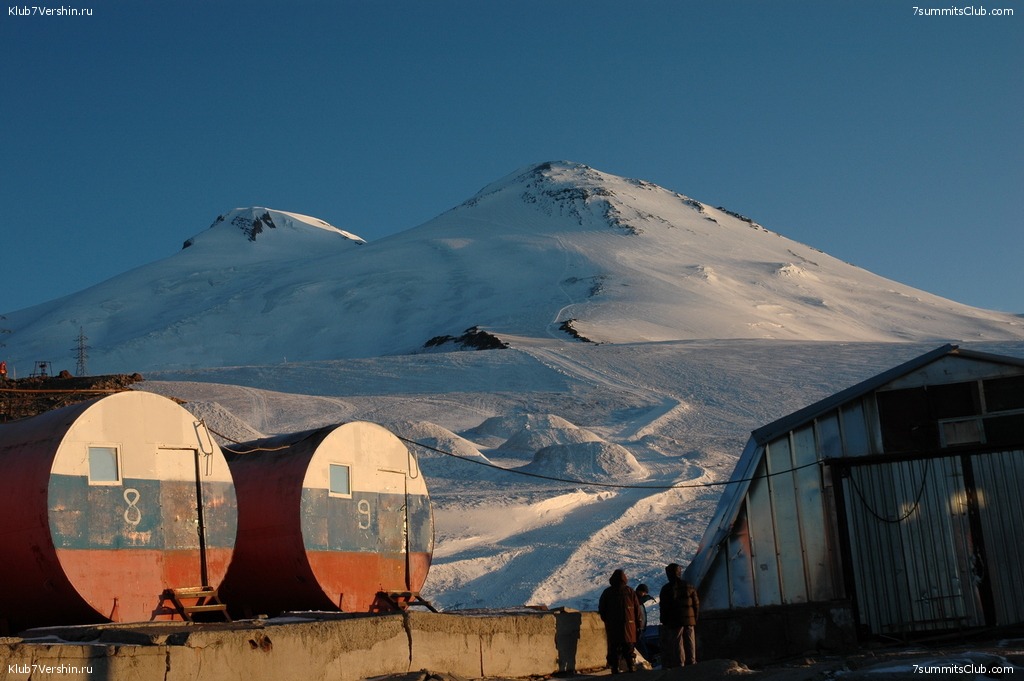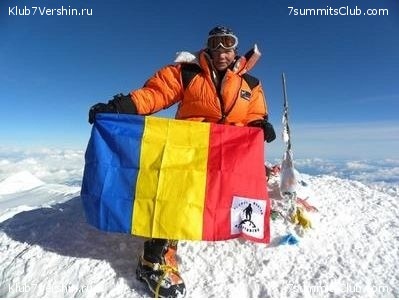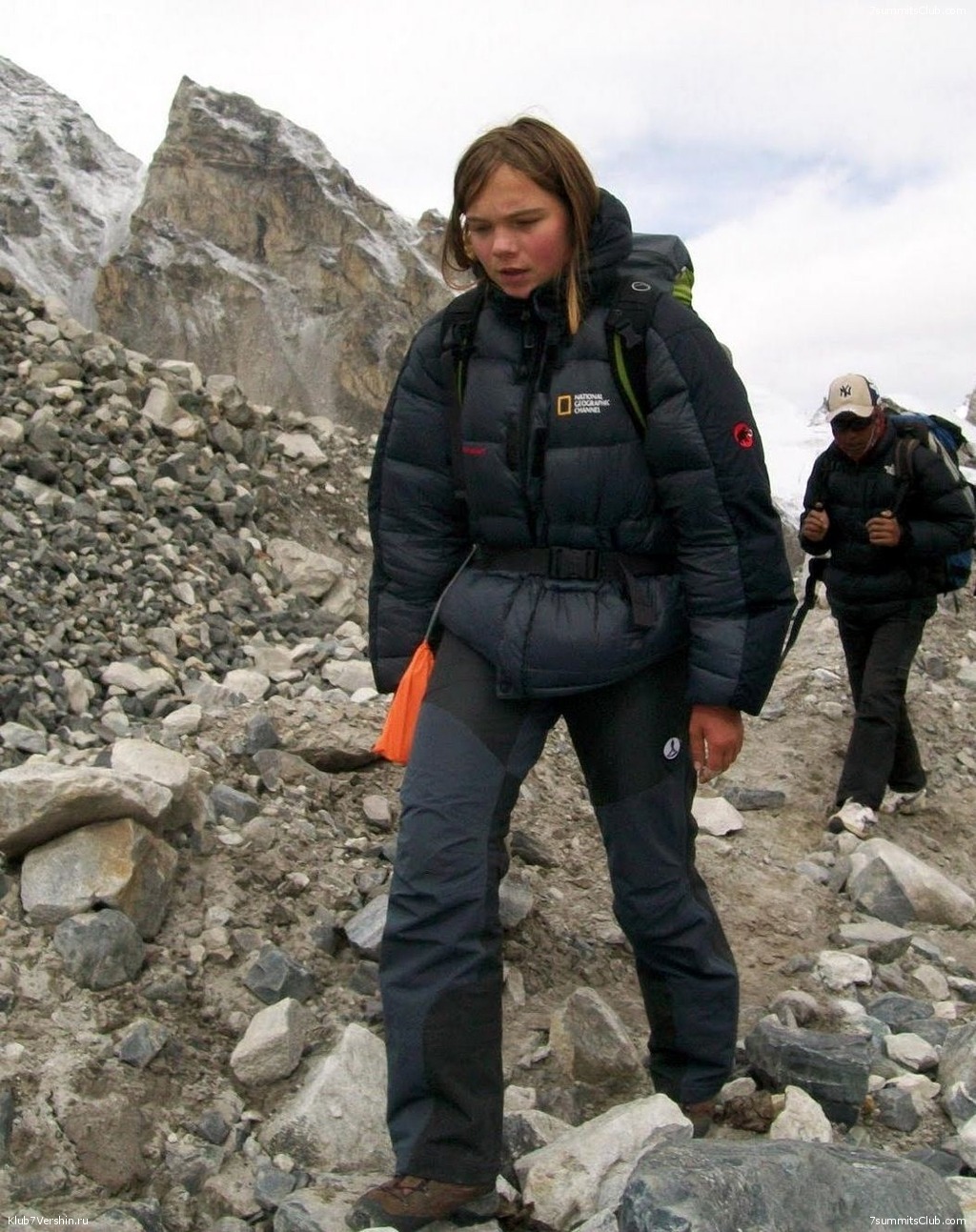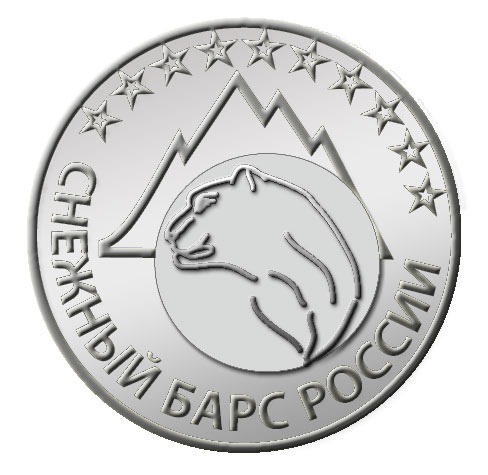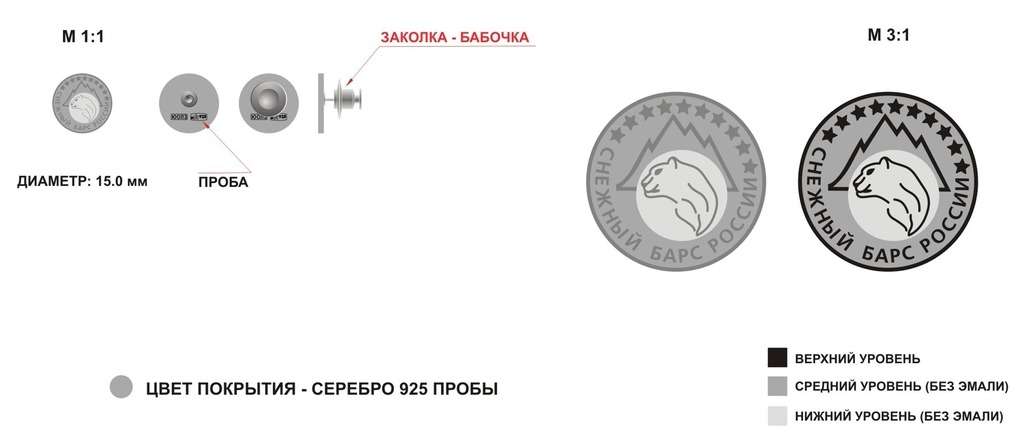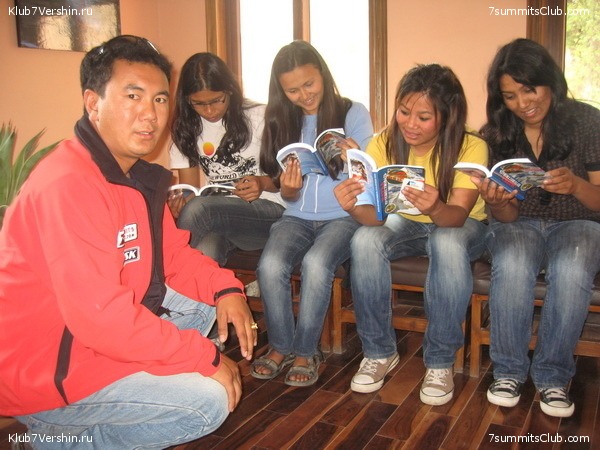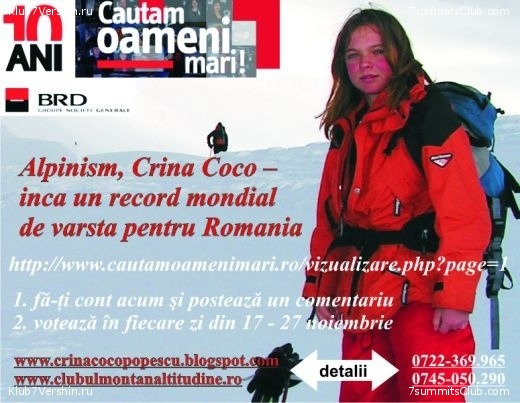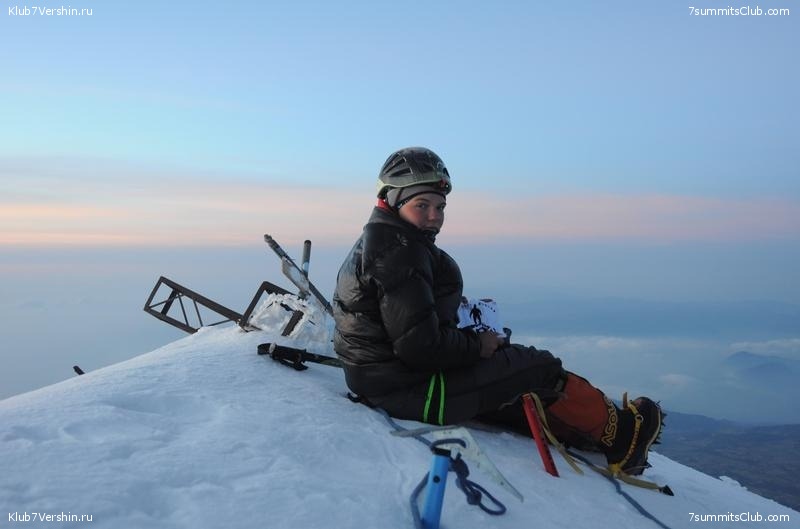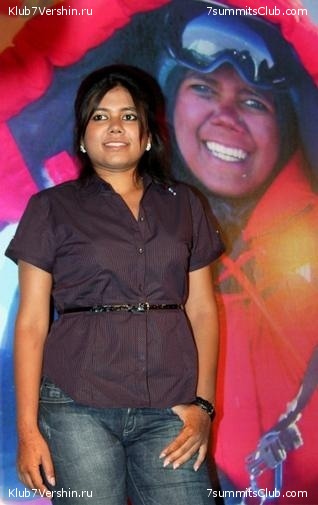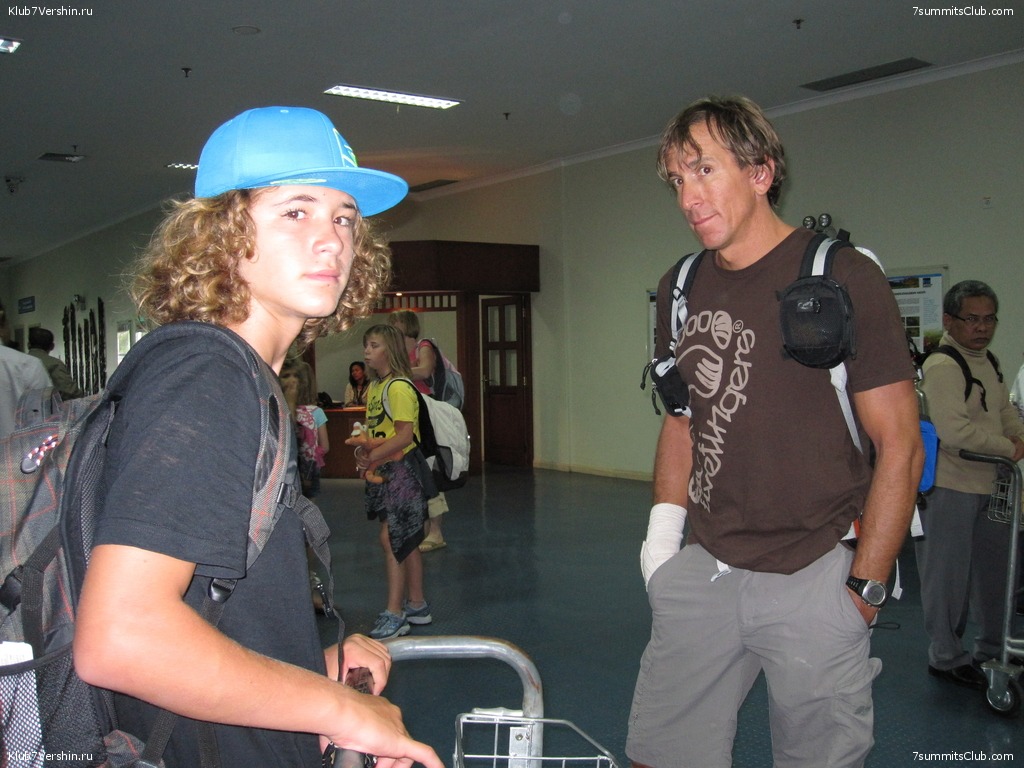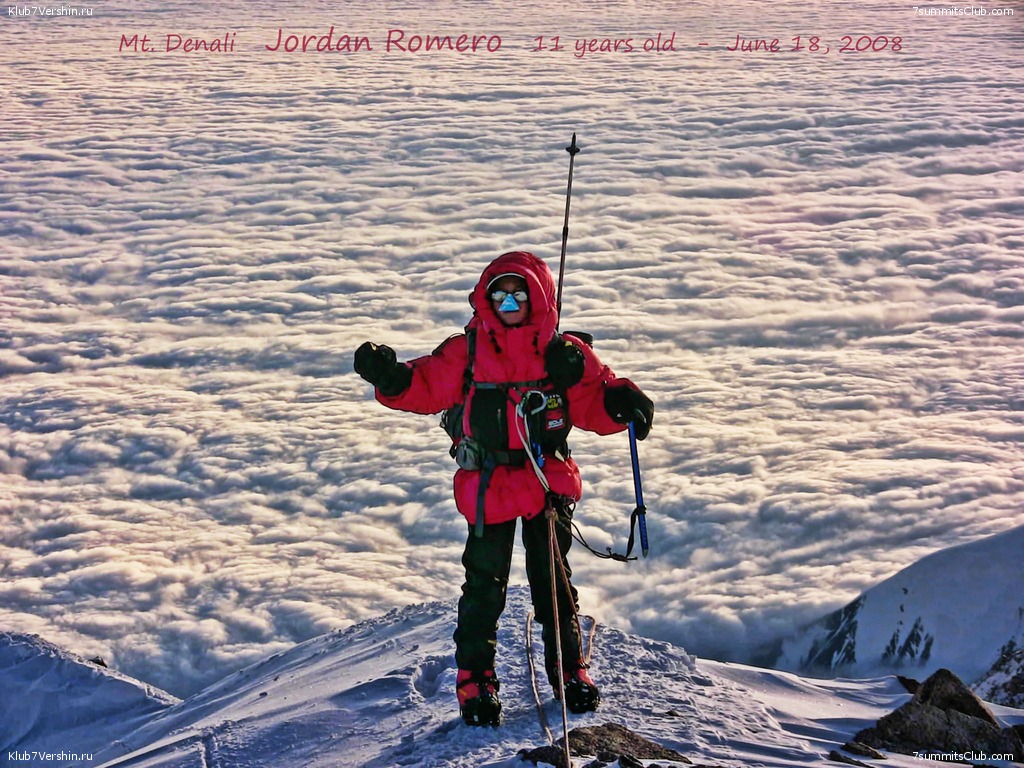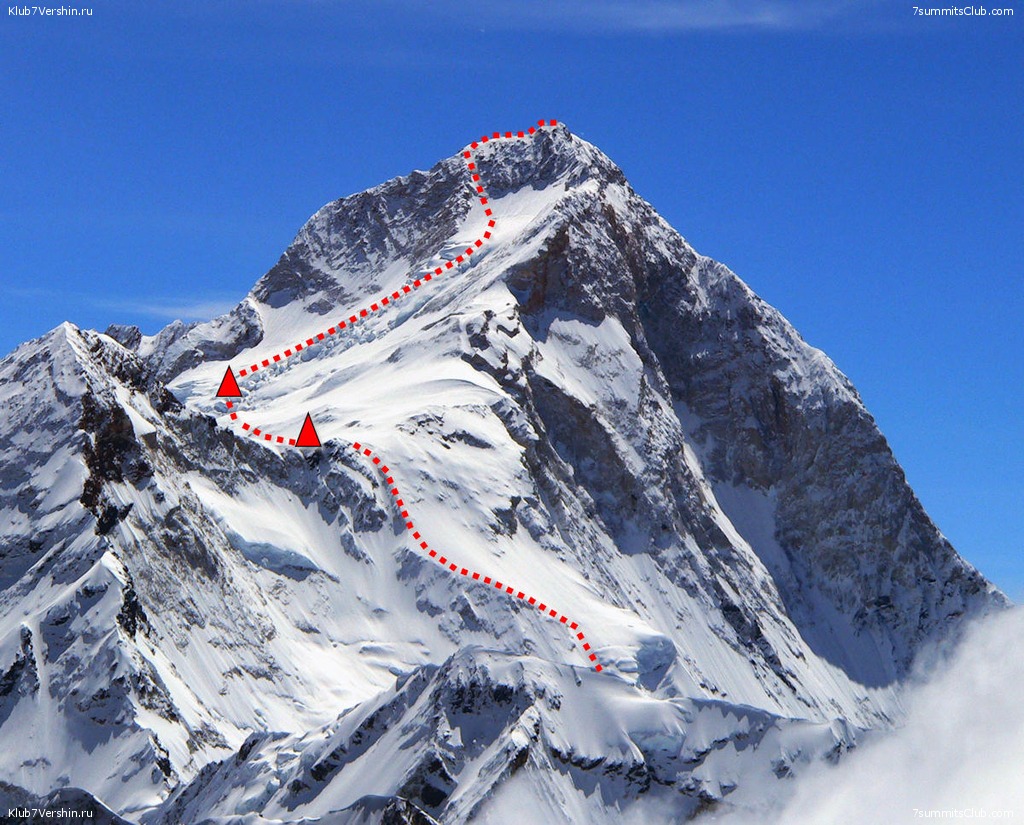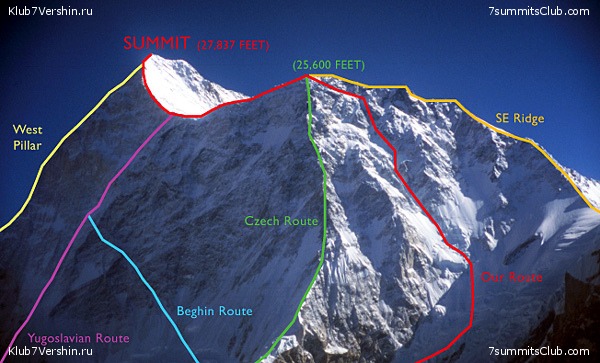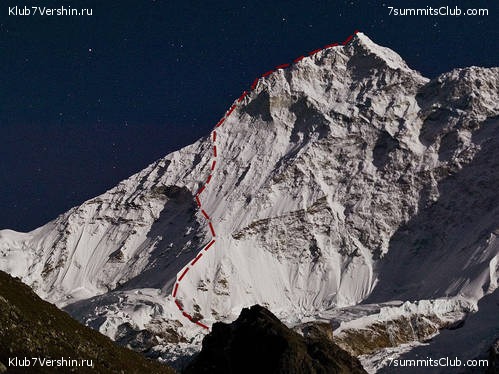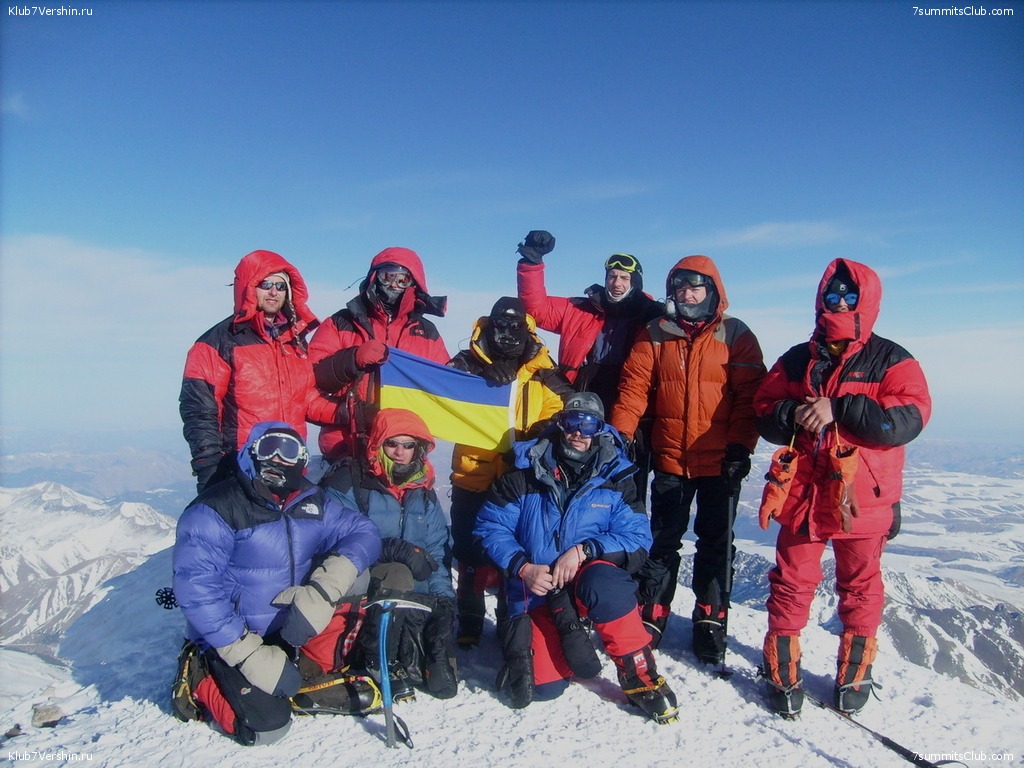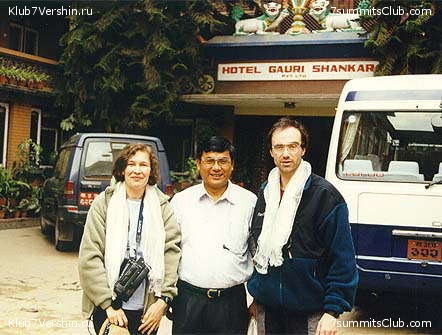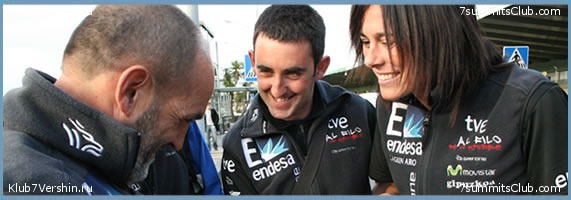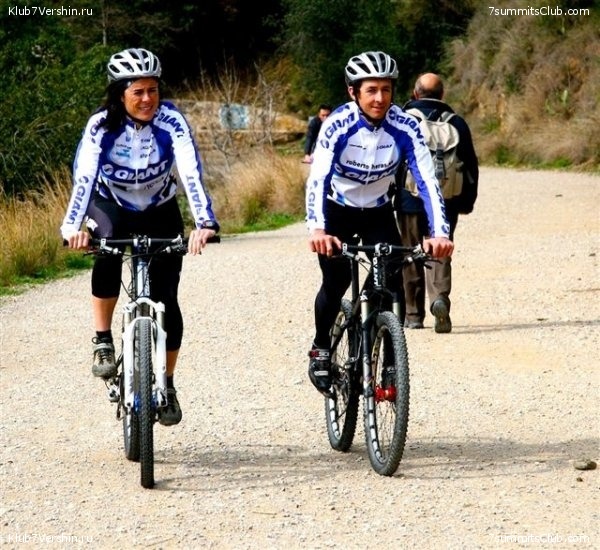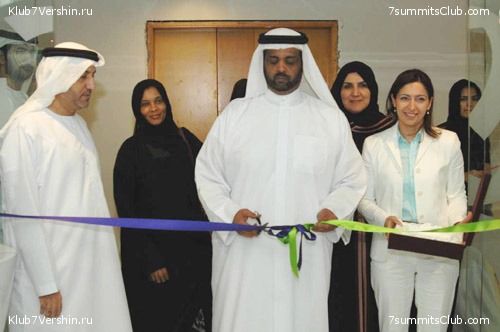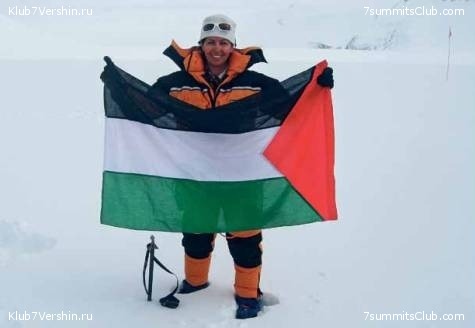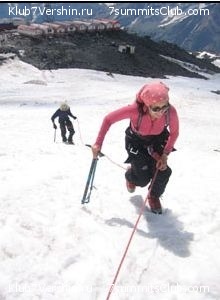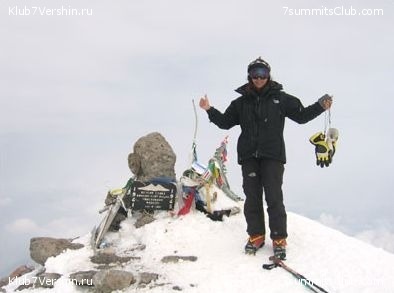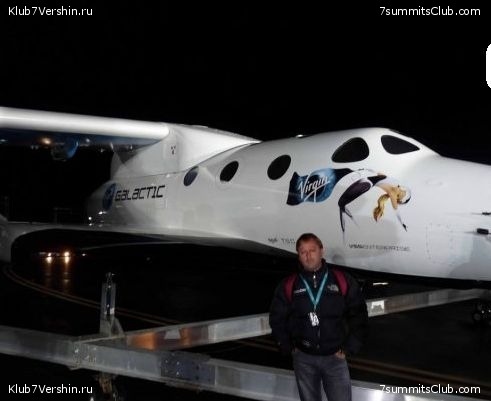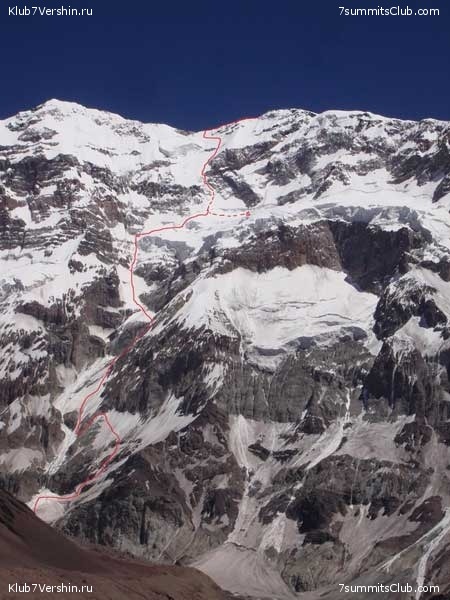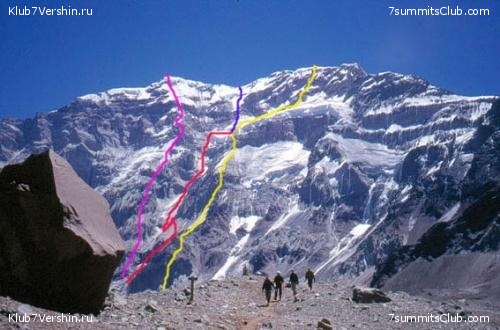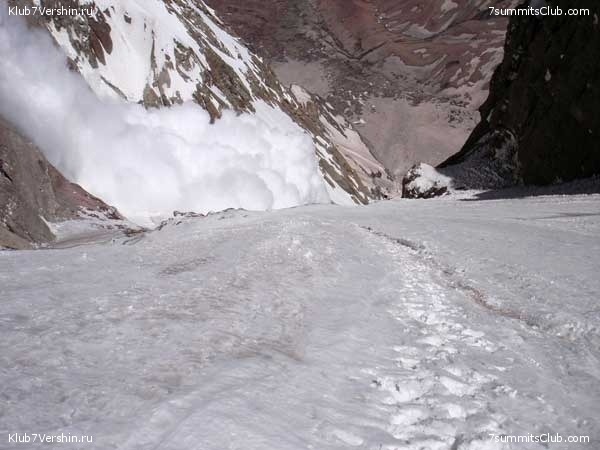World mountain's news - Page 9
I want to climb Kilimanjaro before I die: Bill Clinton
Everest.
VIENNA (AFP) – At the age of 63, former US president says he has one more mountain to climb before he dies -- and that's Kilimanjaro, the highest peak in Africa. Clinton revealed the secret goal -- along with his dream of running a ...
VIENNA (AFP) – At the age of 63, former US president says he has one more mountain to climb before he dies -- and that's Kilimanjaro, the highest peak in Africa.
Clinton revealed the secret goal -- along with his dream of running a marathon -- while in reflective mood at the 18th International AIDS Conference, where he made the keynote speech on Monday.
He explained that one of his favourite movies was "The Bucket List," a 2007 film in which two terminally ill men, played by Morgan Freeman and Jack Nicholson, draw up a list of things they wish to do before they die, and then travel around the world to do just that.
"I'll soon be 64, so I think I'm old enough to join Jack and Morgan in making a bucket list, but I have an A list and a B list, and the B list would be fun to do but doesn't amount to a hill of beans whether I get to do it or not," said Clinton.
"I'd like to climb Kilimanjaro before the snows melt, I'd like to run a marathon before I give out, there's lots of things I'd like to do but it doesn't really matter whether I do them."
Clinton said his "A" list was far more important than his "B" list..
"What I'd really like to do if I could have my wishes, I would like to live to see my own grandchildren.
"And I'd like to live to know that all the grandchildren of the world will have the chance in the not too distant future to live their own dreams and not die before their time."
Located in northern Tanzania, Mount Kilimanjaro, 5,963 metres (19,563 feet) high, draws thousands of hikers a year to its long but relatively gentle slopes. Walkers stay in camps at several phases on the climb before ascending the final stage at night to enjoy the view of the African plains at dawn from the peak.
In 2009 a US study warned that the snows capping Kilimanjaro could vanish altogether in 20 years, most likely due to global warming.
A veteran campaigner who has attended every International AIDS Conference since 2002 -- this is the fifth since then -- Clinton quipped that he relished the ability to speak freely since leaving office, despite the downside of being an ex-president.
"That's the great thing about not being president anymore, I can say whatever I want," he said.
He then added to a swell of laughter from the audience: "Of course, nobody cares what I say anymore, but I can say it!"
Second from Seven for Nepal Women Team
Elbrus.
We are waiting for them in Elbrus. Report: “ Our team climbed Mt Kosciuszko/Targangil on 7th July. It was a beautiful clear day. It was incredible experience to climb one of the world’s oldest mountains. Like they say in ...
We are waiting for them in Elbrus. Report: “ Our team climbed Mt Kosciuszko/Targangil on 7th July. It was a beautiful clear day. It was incredible experience to climb one of the world’s oldest mountains. Like they say in Australia, it may not be the tallest mountain in the world but it certainly makes you feel like on top of the world.
Outdoor Education Group from Moss Vale and Wilderness Sports made all the arrangements for the climb. Kosciuszko National Park helped with much information on the impact of climate change on the Snowy Montains. Ranger Rob Gibbs and Apline Scientist Ken Green accompanied the team on the summit along with friends from The Crossing Land Education Trust, Veg Climate Alliance and media.
We learnt from Ken that Australia has lost 30% of its snow in last 50 years. Mountain Pygmy Possum and alpine vegetation that used to get thick snow cover to hibernate underneath are now exposed to frost as there is not enough snow. As a result, certain species are threathened as cold is killing them”
Site: http://sevensummitswomen.org/
--
The team
The team members came together in 2007 to climb Mt Everest in 2008 spring. The expedition was called ‘First Inclusive Women Sagarmatha Expedition 2008 Spring’ (FIWSE).
Fastest climber to summit Everest Mr Pemba Dorje Sherpa brought forward the idea of organizing a Nepali women’s Everest expedition in order to increase their participation in mountaineering. Only seven Nepali women had reached the top of the world till 2007.
Mr DaGombu Sherpa and Ms Susmita Maskey joined the organizing committee. Nine women, who are now on a mission to climb the 7 summits, joined the team as climbing members.
FIWSE faced several challenges. It was not easy for the team to raise an enormous budget required for the expedition. Thanks to Nepal Government, United Nations World Food Programme, BP Koirala India-Nepal Foundation, United Nations Development Programme, MTV Exit, Swiss Agency for Development and Cooperation and many of our supporters, FIWSE was able to create history.
All women in the team made it to the summit and by May 25th, 2008, FIWSE became the most successful and largest women expedition to climb Everest. Also, first Nepali women from Brahmin, Gurung, Danwar and Chettri communities reached the top of the world.
The climbing members started a non-profit, non-government organization Global Inclusive Adventure Organiation (GIA) after the expedition. GIA focuses on environmental, empowerment and educational aspects of tourism sector.
The team traveled across sixteen districts of Nepal visiting schools and motivating students to climb their own mountains in a program called ‘Inclusive Sagarmatha Speakers’ , supported by United Nations World Food Programme. After the expedition, it was during the school program the team witnessed instances of climate change in various parts of Nepal. This encouraged the team to carry with them a message for climate action.
Everest Women 7 Summits Eco-Action, GIA’s brainchild was thus born.
Shailee Basnet (Coordinator) - A graduate of Business Information Systems and a Post Graduate of Journalism, she works as a reporter for Himalmedia. She became interested in climbing and mountaineering because of the physical and mental challenges it poses, which are quite different from her line of work. Lack of involvement in any kind of sports during her early years made her interested in challenging her limits as she grew up. At 25 years of age she reached a new height on May 24th 2008 by standing on top of Everest.
Asha Kumari Singh - A 24-year-old student, Asha comes from Danuwar community from Meghrail, Mahottari. She comes from a society where women are barely aware of their rights, are supposed to get married off sooner than later and dowry is rampant. Thanks to her grandmother who thought Asha was the ugliest girl among all five sisters and hence thought it was necessary to educate her, in case nobody wanted her marry her. Asha however was not worried about her looks but coming from the flatlands of Terai, was always curious about high mountains. She came to Kathmandu for higher education and got an opportunity to join the Female Outdoor Leadership training in the Annapurnas in the year 2004. Given her background she challenged conventions and impressed naysayers when she started climbing. She made not only her community but also the entire nation proud as she stood on top of Everest on 24th of May 2008.
Chunu Shrestha - Hailing from a poor Kathmandu family, Chunu began working to help support her family while she was just a sixth grader. Despite the financial hardships, she finished high school and started pursuing her education in Bachelors of Arts. When she heard about Susmita Maskey’s summit attempt in 2005, she became inspired by the possibility of succeeding in adventure tourism to support her family. With FIWSE she was able to nurture her passion for the outdoors that she dreamt about during her long days of work. At 27 years of age, she reached the Everest summit on the 25th of May 2008.
Nimdoma Sherpa - Still in high school, Nim is the youngest woman to climb Everest. Despite her small stature, she is dauntless and a very good climber, who impressed everyone during the Basic Mountaineering Course. She had her own struggle on the personal front. Her father passed away while she was a tenth grader. Still she continued her education, subsequently becoming the first in her family to complete the School Leaving Certificate (SLC). She spent lonely childhood in Kathmandu away from her mother for education. She took care of household chores while other children played. But she knew her life was destined to be different than that of everyone else around her. When she learnt about First Inclusive Women Sagarmatha Expedition she knew this is what she was waiting for. At 17 years, she set foot on the top of the world on the 22nd of May 2008. She is ruling wall climbing national champion.
Pema Diki Sherpa - Pema Diki, 22, is one of the three girls born to a struggling couple who moved to Kathmandu from Dolakha with nothing but the clothes on their backs. Two years before joining the expedition, a chance to trek in Gosainkunda enchanted this acupuncture assistant. Basic Mountaineering Course presented her more challenges which left her with desire for more climbing experience. She achieved what she had long dreamt for on 24th of May 2008 when she bowed her head to Cholmolungma, the mother goddess of the world. She has great faith in education and as a child dreamt of being a teacher. The team has been conducting educational interaction in different parts of the country, sharing the experience of struggles and lessons learnt during the expedition, motivating students to believe in their dreams. With this program her childhood dream became reality. She aspires to travel and learn more in life and share her knowledge and experiences with youth all over the world.
Pujan Acharya - Pujan worked as a human rights activist in Dolakha. From early on, despite growing in a society where women are supposed to stick to household chores, she had a passion for sports. In her village, she used to play with men for there wouldn’t be women players. An accomplished volleyball player and marathon runner, Pujan, 25, holds several awards for competition at the district Level. But that was not enough for someone who grew up at the foot of Rolwaling Himalayas. She gained her first mountaineering experience in 2003 when she completed Female Outdoor Leadership training. Finally she made it to the summit of Mt. Everest on 22nd of May 2008. She enjoyed a different taste of Everest and adventure as she skydived in the Everest region on 17th October, 2009 from 29,300 ft. During the cabinet meeting of Nepal Government held at Kalapatthar (5240 m), she actively participated as a venue manager.
Maya Gurung - Maya had a childhood marred with struggle and was an early rebel. She saw poor state of women both in her home and village. She always wanted to break free from it. Maya tried hands on various fields including bowling where she reigned as national champion for four years. But nothing really satisfied Maya before she went ahead to join Basic Mountaineering Course and then to climb Everest. This rebel at heart finally lived her dream of climbing on top of the world on 22nd of May 2008, and became the first Gurung woman summiteer at the age of 28. She lived her long cherished dream of sky diving on 10th October, 2008 with Everest in the backdrop. Maya led the Mt Manaslu clean-up expedition as coordinator and also was active venue manager for the cabinet meeting of Nepal Government held at Kalapatthar (5240 m) on 4th December, 2009. Her dream is to see women empowered and educated so that they are at least able to stand up for themselves.
Ngabhang Phuti Sherpa - Ngawang is from Taplejung district, home of Kanchenjunga. She lost her parents in an early age. She and her elder sister quit education to take odd jobs to look after younger siblings. She ran a restaurant in Kathmandu for couple years and quit it later after her sister went abroad. Several Sherpa climbers encouraged her to explore mountaineering. But she did not like the idea of climbing alone. When she learnt that a women’s team was being put together for climbing Everest, her hidden desire made her give it a shot. This 33-year-old woman felt she did the right thing when she joined Basic Mountaineering Course. On the 22nd of May 2008, she reached her highest destination, Mount Everest.
Usha Bist - Born as fifth daughter in the Far-Western district of Kailali, Usha was left in the jungle for dead. That’s what earned her nickname Bandevi- goddess of the forest. It was a fellow villager who saved the new-born. From early on, Usha was inspired by women climbers and wanted to climb Mt Everest herself. She came to Kathmandu to climb Everest, not knowing where to start. She completed basic and advanced mountaineering courses, climbed a number of peaks including the notorious Amadablam. In 2007, she earned spot in the Loktantrik Expedition Team, to attempt Everest. She was left behind at 8,400m and later rescued. To everybody’s surprise, this 24 year old finally stepped on the top of the world a year later. Her connection to forest is still alive as she is the president of Sasakta Mahila Samudayik Ban in her home district.
Seven summits to fly from. Project of South African climbers
Elbrus.
A team of three intrepid athletes is preparing to climb the seven highest mountains on all seven continents, and then paraglide down, to raise funds for charity. THE paraglider slowly drifted down from the ...
A team of three intrepid athletes is preparing to climb the seven highest mountains on all seven continents, and then paraglide down, to raise funds for charity.
THE paraglider slowly drifted down from the blue sky, moving in broad circles as he lined up to land alongside a banner reading "Seven summits, 7 flights".
Pierre Carter paraglides in to the press briefing at Delta Park Pierre Carter's aim was perfect - he landed softy and gently ran up to the crowd gathered in Delta Park in northern Joburg, his rectangular orange and white parachute billowing behind him.
Carter is one of three athletes to tackle this "journey of a life time", in which they will be the first team in the world to summit the highest mountain on each of the seven continents, and once on the summits, paraglide down to their starting points. The other members of the team are 33-year-old Marianne Schwankhart and Peter Friedman. Carter and Friedman are both 43.
They will set off on Sunday, 11 July and begin by tackling Mount Elbrus in Russia, at 5 642 metres. The other summits on which they will be leaving their footprints are: Carstensz Pyramid in West Papua, Indonesia (4 884m), Mount Vinson in Antarctica (4 897m), Kilimanjaro in Tanzania (5 895m), Denali in Alaska (6 194m), Aconcagua in Argentina (6 959m), and the tallest of them all, Everest in Nepal (8 850m).
They admit that Carstensz Pyramid is the one that makes them the most nervous; despite the fact that it is the lowest, it is the most dangerous, and no one has ever tried to paraglide off it before.
"Walking back down a mountain is the most dangerous part of climbing, so paragliding down will reduce the risks," says Carter. All three members of the expedition recognise that there are great risks involved.
Problems for paragliders at these heights include strong winds and temperatures dropping to -30°C, or -50°C with the wind chill element. If the winds are too strong they will have to wait until they drop, for up to eight hours, if necessary.
The three have had special lightweight gliders made, weighing 10 kilograms. A standard glider weighs 40kgs.
Carter and Schwankhart will do a tandem paraglide off the summits, so that Schwankhart can photograph the summits on the way down, while Friedman will attempt the flights as a single glider. They will be taking along two cameramen, Guy Habbard and Kyle O'Donaghue, to capture the three of them climbing and flying. Both are climbers as well.
Everest
The idea originates with Carter, who has had this dream since 1991. The team expects to finish the challenge in around two years, largely driven by financial constraints and weather and seasons. For instance, Mount Everest can only be climbed between March and May.
The idea of climbing the seven summits originated with Dick Bass in 1985. Since then more than 200 people have climbed all seven. Climbing and paragliding off them has been attempted before, by a French couple, but they never completed the task.
Carter has been paragliding since 1988, and represented South Africa in the world paragliding championships for five consecutive years between 1991 and 1995. He has been climbing for almost 30 years and has summited and paraglided off two of the seven mountains - Elbrus and Aconcagua. He is considered to be one of the 15 greatest paragliders in the world, and will be the team leader of the expedition.
Mountaineer
Schwankhart, an award-winning photo journalist with The Times newspaper, has been a climber since 1995. She was the first woman to climb the sheer east face of the central tower of the Torres del Paine in Chile in 2003, and returned in 2008 and climbed all three of the peaks, again setting the record for a woman.
Paragliding off Mt Elbrus in Russia In 2005, she climbed the Trango Tower in Pakistan - 900m of vertical rock face - to a height of 6 500m. The same year she climbed Cerro Torre in Patagonia, Argentina. Climbing a sheer cliff face requires the climber to sleep for several nights on the mountain, sleeping in a suspended hammock-like contraption, hanging from the mountainside.
In 2006, she filmed No Need for Parking - an Africa Rock Adventure, a record of her climbs in southern Africa. Remarkably, Schwankhart doesn't see the climbing or the sub-zero temperatures as her greatest challenge in the venture; she wants to be able to take good photographs.
"The purpose of my trip is to take amazing photographs, so I hope I can do this. My main worry is whether my camera batteries are charged," she explains. The climbing is of secondary concern. "Mount Elbrus is an easy mountain, I am not too worried. I can rely on muscle memory for the climb."
She is not a paraglider though, and is a little concerned about being air sick.
Friedman has been paragliding for eight years and has fixed-wing and helicopter licences. He has a black belt in karate and has represented South Africa in Japan at the world karate championships. He has also represented South Africa in the world surf skiing championships in the United States.
He has been the driving force behind putting the expedition together, raising the all-important funding and sponsors.
Flight from Elbrus by Carter
Funds
The expedition will be raising funds for The Trust, an organisation that raises funds for 100 charities, with causes ranging from crime survivors, abused animals, HIV and Aids sufferers, to protecting the environment. This year's particular cause is fighting human trafficking, in partnership with Cintron Africa, says Tracey-Lee Cohen, the managing trustee.
The Trust will run a series of TV and radio adverts by R&B singer Akon to assist in raising awareness of human trafficking. "The anti-human trafficking case is just one example of a social cause that will benefit from the bravery and initiative shown by the 7 Summits 7 Flights team," says Cohen.
The expedition will also be raising funds for The Smile Foundation, a charity involved in assisting children with facial anomalies get surgery.
"We admire the dedicated work of charitable organisations such as The Smile Foundation and hope to help provide them with the resources and funds they need to do their work and overcome their own challenges," says Carter.
The three estimate they will need about R7-million to complete the whole venture. All the gear has been sponsored, but funding is still needed. Donations can be made through their website.
The team can be followed on a range of social media: they will be updating their website, Twitter and Facebook pages every few days, and articles will appear in The Times newspaper. DSTV will provide R2-million in airtime to the expedition.
Read more: http://www.joburg.org.za/content/view/5430/266/#ixzz0tBukqMMj
*********************************************************************
THE MISSION
7 Summits 7 Flights is an initiative pioneered by Pierre Carter, Marianne Schwankhart and Peter Friedmann with the aim of raising funds for Smile Foundation and The Trust, an umbrella charity providing a safe and transparent conduit to various charities, by climbing to the summits of the highest mountains of each of the seven continents and paraglide from their summits. All contributions will benefit both charities as well as the Seven Summit Seven Flights project.
The notion of climbing the seven summits was first conceptualized by Dick Bass, an American businessman and amateur climber, who completed all seven summits in 1985. Since then, more than 200 climbers have completed the challenge, with the youngest being eighteen year-old Samantha Larson and the oldest seventy three year-old Ram—n Blanco. What makes this initiative remarkable, apart from the sheer challenge that the seven summits pose, is that the three climbers will paraglide their descent, a feat that has never been achieved, although attempted. To share the experience as closely as possible, award-winning photographer Marianne will fly in tandem with acclaimed paragliding adventurer, Pierre, to photograph and document the journey and the mountains, thus providing a unique view of the adventure from a new perspective where no one else has gone before. Two experienced film crew will compile the video footage into a documentary that will be screened worldwide.
Apart from the thrill of paragliding off all seven summits, the hope of the South African team, is that the time and effort invested in this endeavor will help South Africans in need; that the obstacles they overcome in their struggles against nature will eliminate the obstacles that many face back at home. For the team, the risk that this challenge poses is a chance of a lifetime to realize the limits of the human body in dire situations “it’s not the mountain we conquer but ourselves”. Sir Edmund Hillary. In addition to enriching their own lives, their motivation for this endeavor is to translate their life changing experience into changing the lives of thousands of less fortunate South Africans and at the same time bringing climate awareness, something highly necessary in light of our current climate change crisis.
The project launches in June, with our first trip to Denali Ð we hope to complete all seven summits within fourteen months. By teaming up with The Trust as the beneficiary of this project, 7Summits7Flights is truly an example of climbing for humanity.
It’s the ultimate adventure!
Three explorers will climb to the summits of the 7 highest mountains on the 7 continents and paraglide off them. No-one as yet has flown from the top of all seven summits and this will raise the bar in extreme adventure and exploration in 2010. They will share their experience via photographs, video and blogs from the most remote and fragile corners of the earth. This will allow others to realise their potential for our planet and will raise money for “The Trust”, a charity aimed at assisting the underprivileged in reaching for their own dreams.
12-year old alpinist Matt Moniz summits Denali, Whitney and Elbert....
McKinley.
12-year old alpinist, Matt Moniz summits Denali, Whitney and Elbert to raise money and awareness for best friend's illness. Matt Moniz is the newest and youngest alpinist on the Mountain Hardwear Athlete Team. This 12-year-old from Boulder, ...
12-year old alpinist, Matt Moniz summits Denali, Whitney and Elbert to raise money and awareness for best friend's illness. Matt Moniz is the newest and youngest alpinist on the Mountain Hardwear Athlete Team. This 12-year-old from Boulder, CO has an impressive climbing resume with Denali, Mt. Whitney and Mt. Elbert as his most recent accomplishments. But his climbing serves a greater goal: to raise funds and awareness for pulmonary arterial hypertension (PAH), high blood pressure in the arteries of the lungs.
At age twelve, Matt Moniz is a passionate and naturally skilled alpinist having climbed to Mt. Everest Base Camp and summited Cerro Aconcagua, Mt. Elbrus, and Mt. Kilimanjaro. Most recently, Matt summited a tall trio of North American peaks in just eight days. On June 3rd, he summited Mt. McKinley (Denali at 20,320 ft., the highest peak in North America), Mt. Whitney on June 8th (14,505 ft., highest in the contiguous U.S.), and Mt. Elbert (14,443 ft., the 2nd highest in the lower 48) on June 11th. He was in the company of his favorite climbing partner and father, Mike Moniz, and their hand-picked crew.
But Matt isn't your average mountain climber or your average kid. "Matt has impressed us on every level, as an athlete, an alpinist and as a kid with a really big heart," said Chris Strasser, Mountain Hardwear's athlete and promotions manager. "He climbs for a bigger purpose."
Shortly after summiting Cerro Aconcagua in 2008, and the youngest person to do so, Matt started getting a lot of attention from media and the climbing community. Shortly thereafter, his dad told him, "Heroes are those who help others." It was then he decided to start climbing for a purpose, and that purpose was his best friend Iain Hess who suffers from pulmonary arterial hypertension (PAH), high blood pressure in the arteries of the lungs. "I thought about the shortness of breath you feel when climbing a big mountain, and how it is exactly how Iain feels everyday of his life," said Matt. PAH symptoms include fatigue, shortness of breath and dizziness similar to the symptoms of pulmonary edema commonly experienced by mountain climbers at high elevations.
In July 2009, Matt launched an expedition to climb fourteen of Colorado's famed 14,000 foot peaks in fourteen days ultimately raising $20,000 dollars for PAH research through the Iain Hess Breath Easy Fund. Matt and his team successfully summited each of the fourteen peaks in just eight days. They covered a total of 36,846 vertical feet and 65 miles bringing national attention to this rare and little-understood disease. Mountain Hardwear contributed $1000 to the fund by sponsoring Matt's ascent of Mount Elbert, the highest peak in Colorado.
Mountain Hardwear is thrilled to support Matt in his high alpine adventures and honored to have such an exceptional young man on the Mountain Hardwear Athlete Team. For more information about Matt, his expeditions and his fundraising efforts for PAH, please visit: MountainHardwear.com, Climb7.com or http://climb7.com/Blog/.
Matt also serves as an Outdoor Nation Ambassador working to empower youth to reclaim, redefine and rediscover the outdoors. He will be attending Outdoor Nation's Youth Summit in New York City on June 19-20, 2010.
The “North Caucasus Resorts” state project presented for investors
Elbrus.
Climb Mount Elbrus with us, the best way to visit North Caucasus…. Yet another construction site has emerged in Russia, this time in the North Caucasus. A 5,000 square kilometre area is due to turn into a world-class ski ...
Climb Mount Elbrus with us, the best way to visit North Caucasus….
Yet another construction site has emerged in Russia, this time in the North Caucasus. A 5,000 square kilometre area is due to turn into a world-class ski tourist centre. Some private investors are prepared to invest money in the ambitious project, and the Russian Government has also pledged support. The “North Caucasus Resorts” project, presented at the St. Petersburg Economic Forum, has won the support of the Russian President Dmitry Medvedev.
The concept to develop tourism in the North Caucasus has been encoded “Height 5,642”, which is the height of Elbrus Mount, - the highest peak of Russia and Europe. This is one of the more impressive places the world over, where anyone enjoys staying during any season of the year. But so far tourists could basically enjoy the mountain from afar, since it is only the southern hillside that boasts minimal infrastructure that Alpine skiers and mountain climbers could use to practice their sports.
There’ve been numerous attempts to turn Elbrus into a tourist paradise, but the cost of the project has invariably proved an insurmountable barrier. But now that the Russian Government has decided to invest in the project, albeit partially, the situation has changed for the better. A decision has been made to develop infrastructure both on Mount Elbrus and in the adjacent area, which boasts an overwhelming plant life. As a result the new project comprised several resorts in six republics, namely Dagestan, North Ossetia, Karachayevo-Cherkessia, Adygea and Kabardino-Balkaria, and the Krasnodar Region.
This will help minimize the expenditure and bring the regions closer to each other, Dmitry Medvedev said, and elaborated.
Each of these republics, Dmitry Medvedev says, has its own industry, agriculture, its own problems, but none has had the idea that would bring them together in terms of business. I am certain that if the project is carefully thought out, everything will work out nicely, and nothing can possibly prevent us from carrying it out, including security problems. I hope we will still meet at one of these resorts, Dmitry Medvedev said in conclusion.
Under the project the tourist infrastructure of the North Caucasus will be built from scratch. To make the construction site attractive to investors, each resort will get the status of a special economic area, with preferential tax treatment, loans and other preferences. The project is due to be carried out in 20 years; the original investment will make up some 40 billion roubles; which is slightly more what the Sochi-2014 Olympics project needed for implementation.
Huge funds to be invested are certainly a drawback, but the project also boasts unquestionable advantages, including the creation of new jobs. It is no secret that the mentality of the North Caucasus residents has little to do with an effective development of an industrial complex, but the service sector, restaurants and hotels, are precisely the place where local residents will be happy to work in
Crina Coco Popescu climbed Mt. McKinley
The very young Romanian alpinist Crina Coco Popescu (15) completed climbing the Mount McKinley, the highest peak in North America, reads a release. A member of the Sports Club Altitude Mountaineering and a representative of the Romanian ...
The very young Romanian alpinist Crina Coco Popescu (15) completed climbing the Mount McKinley, the highest peak in North America, reads a release. A member of the Sports Club Altitude Mountaineering and a representative of the Romanian Mountaineering Federation, Crina climbed the fifth peak of the Seven Summits Circuit, the circuit of the highest mountains of each of the seven continents.
Located in Alaska, the Mount McKinley (6,193.5 meters high) is the fifth peak Crina climbed in the Circuit. The climbing took ten days, while the weather was hostile, although most of the expeditions in fine weather, need 14 days, and the authorities of the Denali National Park recommend provisions for 21 days.
At the moment, Coco is the youngest alpinist of the world who succeeded to reach the top of one of the highest mountains of the world listed in the Seven Summit Circuit. Late in 2010, she plans to climb up the Vinson Massif of Antarctica, the last but one in the Seven Summits, as well as the Sidley Mount the highest volcano of Antarctica, the expedition’s costs amounting to 50,000 euros.
A successful expedition would turn Crina in the first she-alpinist of the world, who completes the Volcanic Seven Summits and would take her only one step far from becoming the youngest climber who ends the Seven Summits Circuit.
Coco also joined the North America 2010 Expedition organized by the Sport Mountaineering Altitude Club. Among the expedition’s targets were Pico de Orizaba (5,636 meters), in Mexico, and the Mount McKinley one of the highest peaks of the Continent, and they happened over May 20 – June 21.
New collection of peaks - Snow Leopard of Russia.
Elbrus.
Mountaineering Federation of Russia this year formally approved a new collection of peaks - Snow Leopard of Russia. 7 Summits Club welcomes this initiative, although we consider the list of summits is not optimal. To become a holder, a ...
Mountaineering Federation of Russia this year formally approved a new collection of peaks - Snow Leopard of Russia. 7 Summits Club welcomes this initiative, although we consider the list of summits is not optimal. To become a holder, a climber must climb on 10 Russian famous peaks.
Alex Slotyuk, president of the Federation mountaineering of Moscow was the initiator of the establishment of the title. After several months of discussion, the Board of Mountaineering Federation of Russia approved regulations. Everyone who confirm ascents will be awarded plaques and diplomas.
In order to become a "Snow Leopard Russia" you must climb the following Russian summits:
• Elbrus (5642 meters)
• Dyhtau (5204 meters)
• Koshtan-Tau (5151 m)
• Mizhirgi (5025 meters)
• Pushkin peak (5100 meters)
• Dzhangitau (5085 meters)
• Shkhara (5068 meters)
• Kazbek (5034 m)
• Klyuchevskaya Sopka (4688 m)
• Belukha (4506 meters)
Climber Tejas reclaims Seven Summits record at age 57
McKinley.
"I have made a career of doing the Seven Summits, so it's nice to know that not only can I do them, I can do them the fastest and the most. It's my stamp," Tejas said Friday in a phone interview from his home in New York City. "It's my ...
"I have made a career of doing the Seven Summits, so it's nice to know that not only can I do them, I can do them the fastest and the most. It's my stamp," Tejas said Friday in a phone interview from his home in New York City. "It's my chosen career, and because of that I want to do it well and I want people to know me for it. It's also something I'm very proud of. I've put a lot of energy into it." Tejas said he's been thinking about making a new run at the speed record ever since his previous record was broken back in 2006 by an Indian climber who accomplished the feat in 172 days. Ireland's Ian McKeever lowered the record to 156 days in 2007 and Denmark's Henrik Kristiansen lowered it to 136 in 2008.
MCKINLEY IN 4: At 57, Alaska legend continues to push envelope.
Anchorage Daily News
By BETH BRAGG
bbragg@adn.com
http://www.adn.com/2010/06/04/1307993/climber-tejas-reclaims-seven-summits.html
Published: June 5th, 2010 07:28 PM
The latest feat for Alaska climbing legend Vern Tejas is a high-altitude, record-setting sprint that took him to every corner of the planet and to the top of the highest peak on every continent.
Tejas, who became a household name in Alaska in 1988 when he became the first climber to complete a solo winter ascent of Mount McKinley, returned to the summit of his beloved McKinley on Monday to break the world speed record for climbing the Seven Summits. He did it with two days to spare.
Tejas, 57, climbed the highest peaks on each of the seven continents -- plus a peak in Papua New Guinea that many consider a mandatory eighth climb to complete the package -- in 134 days. The old record, set in 2008 by a Danish climber, was 136.
Perhaps the most remarkable aspect of the accomplishment was the speed with which Tejas made it from the top of Mount Everest in Asia to the top of Mount McKinley in Alaska. He stood atop Everest, which at 29,035 feet is the tallest peak in the world, on May 24. One week later he was standing atop McKinley, which at 20,320 feet is the tallest peak in North America.
"That was a pretty quick one," said Tejas, who spent four days on the slopes of McKinley, a mountain that he said takes most people two weeks to climb.
This is the second time Tejas has owned the Seven Summits speed record; in 2005, he accomplished the feat in 187 days. A guide for Alpine Ascents International whose job takes him to Everest and McKinley almost every year, Tejas also boasts the record for the most Seven Summits completions with nine.
"I have made a career of doing the Seven Summits, so it's nice to know that not only can I do them, I can do them the fastest and the most. It's my stamp," Tejas said Friday in a phone interview from his home in New York City. "It's my chosen career, and because of that I want to do it well and I want people to know me for it. It's also something I'm very proud of. I've put a lot of energy into it."
KEEPING ACCLIMATIZED
Tejas said he's been thinking about making a new run at the speed record ever since his previous record was broken back in 2006 by an Indian climber who accomplished the feat in 172 days. Ireland's Ian McKeever lowered the record to 156 days in 2007 and Denmark's Henrik Kristiansen lowered it to 136 in 2008.
"I got motivated after some uppity Indian climbers decided they were gonna go after it, and it just stuck in my craw that these guys from India who didn't know anything about climbing were going for it," Tejas said. "Neither had much of an inkling or a love of the mountains and it just kinda busted my chops that they were so well-funded they were gonna pull this off and take the record away from me. That made me hungry to get it back."
Kristiansen's 136-day achievement gave Tejas the final nudge he needed to try to reclaim the record.
"It was like a gauntlet going down," he said. "I thought, 'Oh, I should be able to do this.' "
A series of fortunate circumstances helped him along the way, including the chance to share a helicopter ride off Everest with one of his clients who wanted to get to Katmandu in a hurry, saving Tejas a couple of days of hiking. Also assisting his efforts: a guiding job that both paid his expenses for three of the climbs, including Mount Vinson and Everest, and kept him acclimatized to high altitudes on his round-the-world whirlwind.
The guiding job took Tejas up Antarctica's Mount Vinson three times last winter. His third climb up the 16,067-foot peak ended with a Jan. 18 summit -- and started the clock ticking on his record attempt. From there, his journey took him far, wide and high:
• A Jan. 30 summit of South America's 22,820-foot Aconcagua, followed by a quick trip home to New York's Greenwich Village "to say hello to my wife and grab some new gear."
• A Feb. 19 summit of Carstensz Pyramid, a 16,032-foot peak in New Guinea that he climbed while guiding a party of Alpine Ascent clients.
• A Feb. 27 summit of Australia's 7,310-foot Kosciuszko, a one-day climb after which he returned to New York for one day, mostly because airfare to his next stop -- Africa -- was cheaper if his itinerary took him through North America;
• A March 6 summit of Kilimanjaro, a 19,340-foot climb he managed to do in 48 hours instead of the usual six or seven days, in large part because he was already acclimatized;
• A March 20 summit of Russia's 18,510-foot Mount Elbrus, a one-day climb for Tejas but a week-long climb for most others -- another feat made possible by pre-acclimatization, Tejas said.
• A May 24 summit of Everest, an ascent slowed by the fact Tejas was again working as a guide and had to move at his clients' pace, not his. He summitted a week ago Monday, giving him till June 1 -- or nine days -- to descend, fly from Nepal to Anchorage and get to the top of Denali. "That was one of my biggest challenges," Tejas said. "On the 24th of May I was on top of Everest thinking, how am I going to get down, get back to Alaska and get up (Denali) fast enough?"
Providing the answer was a client who, upon reaching Everest's summit, called his girlfriend on a satellite phone and proposed. She accepted, which made the climber so eager to get home that he hired a helicopter to take him off the mountain. The climber knew about Tejas' pursuit of the record, so he invited Tejas to ride to Katmandu.
Once he made it to McKinley, Tejas needed four days to reach the summit of a mountain he has scaled more than 40 times. He climbed to 10,000 feet the first day and 14,000 feet the second day, spent the next day at 14,000 and on the fourth made the push for the summit, getting there in nine hours.
At about 5 p.m. Monday, the clock stopped ticking and the record was his again.
TRAVELING CHEAP
Tejas suspects it's only a matter of time before someone tries to lower the mark even further. And he thinks it can be done faster -- by others, and by him.
Tejas took time off between Kilimanjaro and Elbrus to meet his son in Alaska for a spring-break ski trip to Alyeska. His original plan was to climb McKinley during that span, but his boss at Alpine Ascents worried that a winter ascent of McKinley might make Tejas fatigued, late or both for the start of the climbing season on Everest. So Tejas went to Alyeska instead and put off McKinley.
He joked that his four-month adventure probably set two records -- the speed record, and one for what he called "the most insignificant budget for the Seven Summits."
People like McKeever and Kristiansen often get sponsors to provide six-figure budgets, he said. Tejas was able to cover expenses for three of his climbs -- Vinson, Carstensz Pyramid and Everest -- thanks to his job, and he said he spent an average of $1,000 apiece for the others. He said he's learned to travel cheap over the years.
Tejas will remain in New York for about another week -- his wife, Carole, is a Manhattan attorney he met while guiding on Elbrus a few years ago and married at the top of Mount Vinson in December 2007-- but will be back in crampons in a week or so, when he returns to Alaska to resume guiding on McKinley.
He celebrated his 57th birthday in April, while preparing for the Everest climb, and said he feels fit and strong enough to keep chasing big goals.
"I feel like I'm pretty primed right now," Tejas said. "I feel lucky to have a supportive wife, and a boss who's supportive of my desires to be strong and unusual and different, and to still have my health."
The Seven Summits
• Vinson Massif in Antarctic, 16,067 feet;
• Acongagua in South America, 22,829 feet;
• Kosciuszko in Australia, 7,310 feet;
• Kilimanjaro in Africa, 19,340 feet;
• Elbrus in Russia, 18,510 feet;
• Everest in Asia, 29,035 feet;
• McKinley in North America, 20,320 feet.
(An eighth peak, 16,023-foot Carstensz Pyramid in Papua New Guinea, has in recent years been acknowledged by the international mountaineering community as a must-do climb for those wanting Seven Summits fame. It is part of the Oceania region, sometimes called Australasia, which in some parts of the world is considered a continent that includes Australia.)
Junita scales Russia's Mt Elbrus, gears up for more
Elbrus.
Junita Sambahangphe successfully scaled Mt Elbrus (5,642 metres), Russia, on May 25, at 1:30 pm. Junita who earlier scaled the Mount Everest wants to scale seven summits — the highest mountains in all the continents. Among which ...
Junita Sambahangphe successfully scaled Mt Elbrus (5,642 metres), Russia, on May 25, at 1:30 pm. Junita who earlier scaled the Mount Everest wants to scale seven summits — the highest mountains in all the continents. Among which Sambahangphe has already scaled Mt Everest, Nepal, and Mt Elbrus, Russia. Now, she is planning to climb Mt Denali, USA, later this year.
Sambahangphe has on her expedition list Kilimanjaro (5,895 metres), Denali (6,194 metres), Aconcagua (6,962 metres), Carstensz Pyramid (4,797 metres) and Vinson (4,897 metres) to scale.
Sambahangphe who arrived in Nepal on June 1 said that the total expenditure incurred on scaling Mt Elbrus has been about Rs 7 lakh, including the costs of equipment. The expenditure was borne by Non-Resident Nepalese (NRN) based in Morocco. Sambahangphe was somewhat not happy at government not helping her financially in her expedition.
Currently, she is looking for funds for her future expeditions. Once the financing problem is over, she will start her expedition to Mt Denali in September – October, this year.
“I have started my expedition with a message of, ‘Peace and Tourism Promotion — Nepal Tourism Year 2011’, from Elbrus, Russia, and will continue it till I have scaled all the seven summits,” she said. Her next expedition will cost Rs 15 million and other expeditions, especially to Antarctica, will be the more expensive, she said.
Sambahangphe plans to complete her expedition of scaling all the seven summits by 2013. Her motto through these expeditions is to ‘Save the Himalayas and Promote Nepal as Mountain Tourism Destination’. Sambahangphe, a student of gender studies at Padma Kanya Campus said that a good educational background is a must for people wanting to opt for a career in mountaineering.
Born in Aambung-9, Terhathum, before climbing Everest, she underwent a 35-day mountaineering course at Nepal Mountaineering Association (NMA). She made her first climb of 6,000-metre height, and later scaled the Mt Everest.
The growing mass of people scaling the Mt Everest should be quality mountaineers rather than people having vested interest. Many uneducated people take to mountaineering as a viable career option since it has all the trappings of fame and glory. However, this one is a different story.
Alex Abramov and Mingma Gelu with a group of Nepel women climbing Everest last year
Crina climbed Pico de Orizaba (6.194 m), this is her sixth volcano from the Volcanic Seven Summits
Orizaba.
Ola Senior Abramov, I just came back in 'civilization'. I wanted to let you know last news about our North America 2010 Expedition on Altitude Mountain Club. Last week on May 21th I climbed Pico de Orizaba - highest vulcano in North ...
Ola Senior Abramov,
I just came back in 'civilization'. I wanted to let you know last news about our North America 2010 Expedition on Altitude Mountain Club.
Last week on May 21th I climbed Pico de Orizaba - highest vulcano in North America. As you know already this is the 6th from 7 volcano for me from Volcanic Seven Summit. The last one will be Mt. Sidley in Alaska. As I do know I'm already on a little step to be the first omen who make Volcanic Seven Summits & also the youngest climber....
Next days we do have here in Mexico a meeting with the Romanian Ambasador. She wants to promote my achievements in Mexican Press. Do you mind if I'll put in the press release infos about the expedition in Antarctica & that you'll guide the first women for Volcanic Seven Summits in Antarctica?
Best regards,
COCO
Crina (Coco) Popescu is a 15 year-old alpinist, representing the Romanian Alpinism and Escalade Federation
---
Crina climbed Pico de Orizaba (6.194 m). This is her sixth volcano from the Volcanic Seven Summits
The next challenge for Crina is McKinley (6,194 m) from Alaska, the Altitude Mountain Sportive Club informs. Crina Coco Popescu is a 15 year-old alpinist, representing the Romanian Alpinism and Escalade Federation.
Pico de Orizaba (5,636 m) from Mexico is the highest North American volcano and the sixth volcanoes she escaladed in the circuit of the seventh highest volcanoes on each continent - Volcanic Seven Summits.
Coco is the world's youngest female alpinist to climb the world's highest volcanoes. At the end of 2010, Crina planned to climb Sidley from Antarctica - the last volcano from the Volcanic Seven Summits. The mount on Mt. Sidley in Antarctica would make Coco first world alpinist to climb all there is to climb in the circuit.
The young alpinist Crina Coco Popescu is taking part in the "North America - 2010" expedition organised by the Altitude Mountain Sportive Club. The aims of the expedition is to climb the highest volcanoes on the continent - Pico de Oribaza from Mexico (%,636m) and the highest top on the continent, McKinley (6,194 m) from Alaska.
She was born on December 3, 1994 in Rasnov. Coco is currently a student.
Crina Coco Popescu achievements record:
2010 - 21 May: Mexico – Pico de Orizaba (5635m) – the highest North American volcano, SEVEN VOLCANOES Circuit;
2010 - January.: Papua, Indonesia – Carstensz Pyramid (4884m.), world youngest alpinist in Romania - the highest top in Australia and Oceania, the most technical top in the SEVEN SUMMITS Circuit;
2010 - January.: Papua New Guinea – mount Giluwe (4,368 m), the world’s youngest alpinist, first alpinist from Romania - the highest volcano in Australia and Oceania, SEVEN VOLCANOES Circuit;
2010 - January.: Australia – mount Kosciuszko – the highest mountain in Australia, the Dick Bass version from the SEVEN SUMMITS Circuit;
2009 - July : Russia, mountain Caucasus, top Elbrus (5,642 m) – the highest top in Europe, SEVEN SUMMITS Circuit, the highest volcano in Europe, SEVEN VOLCANOES Circuit;
2009 - June : Tanzania, mountain Kilimanjaro, top Uhuru (5,895 m) – the highest top in Africa, SEVEN SUMMITS Circuit, the highest volcano in Africa, SEVEN VOLCANOES Circuit;
2009 - January.: Argentina, Cordelier Andes – Aconcagua (6,963 m), route "Route Polish Iceberg", the world’s youngest person – the highest top in South America, SUMMITS Circuit;
2008 - December.: Chile, Atacama – top Ojos del Salado (6,893 m), world’s youngest person – world’s highest volcanoes, the highest volcano in South America, SEVEN VOLCANOES Circuit.
2008 - top Alam Kooh (4,850 m), the North face, premiere for Romania;
2008 - the Alborz Massive (Iran), top Damavand (5,671 m), world’s youngest person – highest volcano in Asia, SEVEN VOLCANOES Circuit;
2008 - Mount Caucasus – top Kazbek.(5,047 m) ), world’s youngest person;
2008 - May: Mount Olimp – top Mytikas (2,919 m), in winter;
2007 - Nepal – top Kalapattar (5,550 m), Everest Base Camp;
2007 - Turkey – top Ararat (5,165 m), world’s youngest person;
2007 - Mont Blanc(4,810 m);
2007 - The Alps- Mont Dolent (3,800 m);
2005 - The Alps- Dente del Gigante (4,014 m).
Beautiful Indian girl scales Europe’s highest peak Mt. Elbrus as six of seven summits
Elbrus.
Pune, April 25 (IANS) Braving strong gales and temperatures below minus-20 degrees Celsius, Pune mountaineer Krushnaa Patil Sunday scaled Europe’s highest peak, Mt. Elbrus (5,642 metres). Accompanied by a sole guide, Vladimir from ...
Pune, April 25 (IANS) Braving strong gales and temperatures below minus-20 degrees Celsius, Pune mountaineer Krushnaa Patil Sunday scaled Europe’s highest peak, Mt. Elbrus (5,642 metres).
Accompanied by a sole guide, Vladimir from Russia, Krushnaa started the treacherous climb in a blanket of 20 cms snow at 6 a.m. Sunday.
“Owing to heavy snowfall, low temperatures and strong winds, she had to wait for three days at the base camp for the weather to clear. Luckily, she got a window today to finally attempt the climb and succeeded in reaching the summit by 1 p.m.,” her mother Ranjana Patil told IANS here Sunday night.
By late afternoon, Krushnaa started her descent and is expected to reach base camp - at around 3,694 metres - by early Monday morning, Ranjana, herself an avid mountaineer, said.
With this, Krushnaa has scaled six of the world’s seven tallest peaks in all the continents and her eyes are now set on Mt.McKinley in Alaska (6,194 metres).
Incidentally, last month (March 13), Krushnaa and Ranjana both scaled the 2,228-metre Mt. Koscinszko, the highest Australian peak.
A couple of months before that, Krushnaa summitted South America’s highest peak Mt. Aconcagua - 6,961-metres high - in January this year.
Earlier, in May last year, Krushnaa reached the summit of the world’s highest peak, Mt. Everest (8,848 metres), followed by Africa’s tallest mountain, Mt. Kilimanjaro (5,895 metres) in October and the highest peak in Antarctica, the 4,897-metre tall Mt. Vinson massif, in December.
Ranjana Patil said her daughter plans to conquer even Alaska’s Mt. Mckinley within the next few months. She added preparations are already underway for the effort which will make her the first Indian to scale all the seven peaks in the seven continents of the world.
Krushnaa, who is pursuing Bachelor of Arts (BA) at Pune University, is a professional Indian classical dancer and choreographer. She also designs dance costumes, jewellery and home interiors.
Everest 2010 highlights: Jordan Romero
Everest.
Jordan Romero of Big Bear, Calif., is already an accomplished climber who has reached the tops of some of the world’s highest peaks. At age 10, Jordan and his parents climbed Mount Kilimanjaro in Africa, Mount Kosciusko in Australia, ...
Jordan Romero of Big Bear, Calif., is already an accomplished climber who has reached the tops of some of the world’s highest peaks. At age 10, Jordan and his parents climbed Mount Kilimanjaro in Africa, Mount Kosciusko in Australia, and Mount Elbrus in Europe, Outside Magazine reports. The next year, he was the youngest person ever to climb Aconcagua in South America and Denali in North America. Last year, he climbed Indonesia's Carstensz Pyramid, the highest point in Oceania and the so-called "eighth" summit. Now, along with his father Paul Romero and Paul’s partner, Karen Lundgren, Jordan has his sights set on Everest.
Jordan and Paul Romero
Jordan Romero trains daily to prepare for the extreme hardships of climbing the world’s tallest mountain. No longer in school, he follows an independent study program which allows him to focus on his climbing. The family has two hypoxic tents on loan. His mentors, Romero and Lundgren, are pro adventure racers. But Outside points out that Team Romero seems to operate in a world of all-consuming passions. There are no professional guides on the team, a detail that has experts concerned. If Jordan does complete his record-breaking summit, he'll be the only teen to do so without an experienced Everest climber on his team.
While some point out the importance of Jordan being a role model for active kids, not many Everest climbers support the attempt. Russell Brice is one of Everest's most successful guides. As he told Outside, "I do not see how young people under the age of 18 can gain enough experience about mountaineering or themselves to undertake such a project safely.” Others point out studies on the teenage brain show that it is only 80 percent developed and that to put an emotionally inexperienced child on one of the world’s most dangerous mountains would be irresponsible.
Jordan isn’t letting the doubters stop his efforts. As he told Outside, "I just focus on the goal I set out when I was 9, which is to climb the Seven Summits. I'm just not giving up. Stopping at nothing. I don't let people's doubts bring me down."
FULL ARTICLE IN THE SITE OF OUTSIDE MAGAIZINE
Four or more challenges on Makalu
Makalu.
While the main attention is focused on Annapurna, where women are arguing for the right to be the first on all 14 eightthousanders. Meanwhile, the number of so-called "challenges" in the first place the other giant peak - Makalu. Two teams ...
While the main attention is focused on Annapurna, where women are arguing for the right to be the first on all 14 eightthousanders. Meanwhile, the number of so-called "challenges" in the first place the other giant peak - Makalu. Two teams are planning to make new routes, and the German Luis Stitzinger intends to perform the first ever ski descent from the summit.
41-year-old Stitzinger, in recent years, got a taste for the establishment of outstanding records. He has already made descents on three eight-thousanders, set speed records on the Polish route on Aconcagua, etc. .. His climbing partner is his girtl-friend Alix von Melle, as well a guide, as well an extreme skier. However, on Makalu Luis will skiing alone, too severe would be descent.
Route for ski descent
**********************************************************************
From ExplorersWeb
Americans Chris Warner and Marty Schmidt plan to make waves on a lonelier 8000er: Makalu.
“Marty Schmidt and I are headed to the south side of Makalu, leaving this coming week,” Chris Warner wrote in an email to ExplorersWeb yesterday. “We are hoping to climb a new route to the summit of Makalu SE (7803 meters) and then follow the SE Ridge to the (main) summit.”
Route details
“Our planned route lies between the SW Ridge (opened by Czechs in 1976) and the SE Ridge (Japanese climb in 1970),” expedition website SharedSummits reported. “The route will ascend snow gullies and rock bands, up the 7000 foot face to Makalu SE (7803 meters). Here it joins with the Czech and Japanese routes along the SE ridge, knife-edged and gendarme guarded all the way until the summit.”
“At 8300 meters, a 100 meter rock band blocks the route, making for an extremely technical summit day,” SharedSummits added. The climbers expect to find snow slopes to 60 degrees, ice to 85 degrees and rock sections to 5.7.
Himalaya veterans
Both climbers are highly experienced mountaineers: In addition to new routes on Shivling and winter Ama Dablam, expedition leader Chris Warner has been on 13 expeditions to 8000ers, reaching the summit of Everest (guiding three times), K2, Lhotse, Shisha Pangma (solo south side) and Cho Oyu, plus attempts on Nanga Parbat and Broad Peak.
A regular on Denali and Aconcagua; Marty is a seasoned high mountaineering guide and a four-time Cho Oyu summiteer (including a speed ascent and a ski descent), who also topped-out Kangchenjunga and attempted K2 from both sides.
“Marty Schmidt and I are headed to the south side of Makalu, leaving this coming week,” Chris Warner wrote in an email to ExplorersWeb yesterday. “We are hoping to climb a new route to the summit of Makalu SE (7803 meters) and then follow the SE Ridge to the (main) summit.”
************************************************************************
From Everestnews.com
Will Cross
Will Cross departs shortly for Makalu as part of his Giant Mountain Challenge; a quest to climb six of the highest peaks in the world. All are located in the Himalaya and all are above 8000m. The purpose of this challenge is to demonstrate that one can lead an extraordinary life with diabetes, an incurable condition and a global pandemic. So far, Cross has topped out on Everest, Lhotse and Cho Oyu. He has had diabetes for over thirty years.
Novo Nordisk continues to be the primary corporate partner of this endeavor. Wild Things is the exclusive pack and gear provider. Dermatone is the exclusive sun care protection. HealthiFeet and Adventure Medical Kits have also stepped forward to support the Giant Mountain Challenge.
************************************************************************
March 27, Ukrainian National expedition "Ukraine-Makalu-2010" started from Kiev. The expedition includes 10 climbers, 2 coaches, a doctor. Expedition leader - Valentin Simonenko. The purpose of the expedition - climbing Makalu (8463 m), the fifth summit of the world, by a new route along the South-West Face. This expedition is dedicated to the memory of the famous Ukrainian climber Vladislav Terzyul, who climbed all the Eight-thousanders. He died on the descent is from Makalu, the latest in his list of 14.
The team includes athletes from different regions of the country:
1. Yuri Kruglov - team captain
2. Sergei Pugachev (Gorlovka)
3. Sergei Boublik (Sumy)
4. Maxim Perevalov (Odessa)
5. Vladimir Klebansky (Odessa)
6. Andrew Kiyko (Kharkiv)
7. Alexander Zakolodny (Kharkiv)
8. Paul Kirichek (Kiev)
9. Dmitry Venslavovsky (Vinnitsa)
10. Igor Storozhenko (Donetsk)
Head Coach - Mstislav Gorbenko, the second coach - Michael Zagirnyak, organizer and leader of the expedition, Valentin Simonenko.
Winter Training on Elbrus
Expedition will last 2 months. Upon arrival in Nepal athletes decide to organizational matters, then 8 days walk will reach the base camp .. May 27 athletes plan to return to Ukraine.
The expedition can be monitored at blogging site leader and team captain Yuri Kruglov: kruglov.biz
From the left: Michael Zagirnyak, Yuri Kruglov, Mstislav Gorbenko
Letter from Ang Tshering: Everest and Cho Oyu news
Everest.
Here is Ang Tshering’s letter in full: Namaste and warm greetings from Nepal. I am delighted to inform you that finally the Spring Expedition Season starting soon and I am pleased to share with you many interesting and positive news ...
Here is Ang Tshering’s letter in full:
Namaste and warm greetings from Nepal.
I am delighted to inform you that finally the Spring Expedition Season starting
soon and I am pleased to share with you many interesting and positive news from
Nepal.
Apa Sherpa,World Record Holder for 19 ascents of Mt.Everest and Climbing Leader
of Eco Everest Expedition is heading for 20th Summit on Mt.Everest this Spring
and Asian Trekking family extends their all support and wishes for the success.
Eco Everest Expedition: Once again this year Asian Trekking is organising the
Eco Everest Expedition (2010). Under the leadership of Dawa Steven Sherpa, Apa
Sherpa (19 times Everest Summiteer: world record holder) as the Climbing Leader
and Nanga Dorje Sherpa as Sirdar. The focus will be on climbing in an eco-sensitive
manner, bringing old garbage, and all human waste produced on the mountain down
to base camp for proper disposal. The expedition will once again be using the
highly successful alternative energy solutions like the parabolic solar cookers
and the SteriPENs for water purification.
This year Dawa Steven and his Eco Everest Expedition team has planned to focus
to collect and bring down previous expedition garbage between the altitudes of
6500 m and above. A team of 10 high altitude Sherpas will be hired to clean up
garbage and debris from such high altitudes. Eco Everest Expedition 2009 team
had brought down nearly 6000 kilos of previous expedition garbage from Mt.
Everest under the Cash for Trash program. This year’s Eco Everest Expedition
targets to bring down 1000 kgs of debris from high altitude above Camp 2 (6500m)
and 6000 kgs of debris from Camp 2 and below.
Since the Spring Season is approaching very closed, The following are the
expedition Teams Confirmed up to today through Asian Trekking:
1. Eco Everest Expedition
2. Kazakh Lhotse Expedition
3. International Everest Expedition 1
4. International Everest Expedition 2
5. International Cho-oyu Expedition
6. International Shishapangma Expedition
7. Chilean Amadablam Expedition
8. Korean Himlung Expedition
9. German Cho-oyu Expedition
Please visit: www.asian-trekking.com for details.
Beat the GLOF Event and Save the Himalaya Khumbu Festival will be held at
Khumjung village on 4 June 2010 instead of 10 – 11 June. The date for this event
has been postponed for the convenience of the guests of 3rd International
Sagarmatha (Mt.Everest) Day Celebration, which will be held on 29 May 2010, to
participate in Beat the GLOF Event and Save the Himalaya Khumbu Festival. The
event will be celebrated with various programs which focus on the mountain
communities, the mountain environment and the impacts of climate change on them.
The event will be supported by Idea,Nepal Tourism Board, Sagarmatha National
Park, and many non government organizations.
2nd New International Airport in Nepal: Ministry of Tourism and Civil Aviation
held a ceremony on March 7, 2010 where an agreement was signed between The
Government of Nepal, Ministry of Tourism and Civil Aviation, and Land Mark
Worldwide Co. Ltd., Korea. The agreement was on the detailed feasibility study
of the second international airport at Dhumberwana, Nijgadh; a town situated in
Bara District, 84 kilometers south-east from Kathmandu. The feasibility study
will have to be completed within 10 months from the date of agreement signed.
Nepal Tourism Year 2011 was officially launched on February 26, 2010 and
preparations have already begun which is sure to make way for improvements in
Nepal’s Tourism. All the political parties of Nepal including the Unified Maoist
Communist Party of Nepal (Maoist) have signed an agreement committing not to
call any bandhs or any such strikes that affect the tourists during the period
of Nepal Tourism Year.
Nepal Mountaineering Association (NMA),TAAN and EOAN have appealed and suggested
to The Government of Nepal to help solve many problems prevailing in the
Nepalese mountain tourism. Among the many requests made following are the main
ones.
A) Since 16 July 2008, the Government of Nepal waived off royalty of the opened
peaks in the Midwestern and Farwestern Nepal for five years (till 16 June 2013)
which shows good sign of positive developments in these region. Similarly it was
requested to reduce the royalty fee of the peaks which is less crowded specially
on the border of Nepal. It has been requested to The Government of Nepal to
manage free permit to climb Mt. Cho-yu for five years from Nepal side.
B) The Tourism Council in the Chairmanship of The Right Honourable Prime
Minister had a meeting where the necessity of operating mountaineering
activities through one door policy was accredited. The meeting was decisive in
implementing this policy in order to create a favourable environment for the
climbers.
C) All associations has requested for permission to make the peaks up to 5999m
high permit free and also to handover the management of peaks that are between
6000 to 6700 m to Nepal Mountaineering Association.
D) It has been suggested to The Government of Nepal to reduce the fees of
communication equipments such as walkie-talkies, satellite telephone, radios,
video cameras, documentary filming, mountain filming etc. and equipments used by
climbing expeditions.
E) 3rd International Sagarmatha(Mt.Everest) Day Celebration will be held on 29
May 2010 with various programs. We expect more than 250 Mt.Everest summiteers,
including renowned climbers like Chris Bonington, Peter Habelar, Apa Sherpa, Min
Bahadur Serchan, Dawa Steven Sherpa, Bill Burke, David Liano, to attend the
program. To honour the Mt. Everest summiteers a request letter has been sent to
The Government of Nepal asking to provide them free visas every time they visit
Nepal. The summiteers will be regarded as the Goodwill Ambassadors of Nepal to
promote Nepalese mountain tourism.
F) Mt. Dhaulagiri Golden Jubilee will be celebrated on May 13, 2010 in Pokhara.
Noted climbers like Kurt Diemberger (first summiteer of Mt. Dhaulagiri), and
Reinhold Messner are the Guests of Honour and many other renowned climbers will
be present to celebrate Mt. Dhaulagiri Golden Jubilee. On this occasion, it is
requested that there should be a 50% concession on royalty for all the climbers
of Mt. Dhaulagiri. Likewise the Summiteers of Mt Dhaulagiri should be provided
free visas from 2010 to 2011.
Also please visit the following links:
http://www.climate4life.org
http://www.theuiaa.org/news_219_Letter-from-Ang-Tshering-Sherpa-president-Nepal-Mountaineering-Association
http://www.guardian.co.uk/environment/video/2009/dec/10/copenhagen-sherpa-himalayas
http://www.lindamcmillan.com/picture-gallery http://www.lindamcmillan.com/picture-gallery
http://www.adventuretravelnews.com/updates-from-the-nepal-mountaineering-association
http://www.usaid.gov/press/frontlines/fl_feb10/p09_climate100221.html
http://www.agrobiodiversityplatform.org/blog/?p=2870
http://www.theuiaa.org/act_mountain_protection.html
http://www.everestnews.com/stories2010/everest201001042010.htm
http://www.americanalpineclub.org/exitstrategies
http://www.festivalalpinismu.cz/fotogalerie
http://www.festivalalpinismu.cz/program/2-program-patek
http://www.festivalalpinismu.cz/program/48-nedele22
Finally I would like to express my sincere thanks and gratitude to the Prime
Minister and The Government of Nepal for nominating me as the member of National
Tourism Council and my son Dawa Steven Sherpa as the member of Climate Change
Council to the Prime Minister.
I am also thankful to the International Olympic Committee and Mr. Jacques Rogge,
president of The International Olympic Committee for presenting Dawa Steven
Sherpa the “International Olympic Committee Award for Sports and Environment.”
With kind regards,
Ang Tshering Sherpa
Ten years ago
Start of season; Edurne Pasaban hope to become the first woman on 14 highest peaks
Spanish mountaineer Edurne Pasaban said she hoped to become the first woman to scale the world’s 14 highest peaks by conquering the Shisha Pangma and Annapurna mountains this spring. “I leave on March 4. I still have ...
Spanish mountaineer Edurne Pasaban said she hoped to become the first woman to scale the world’s 14 highest peaks by conquering the Shisha Pangma and Annapurna mountains this spring. “I leave on March 4. I still have Shisha Pangma and Annapurna to do and I aim to try in the spring. I am going first to Shisha and then to Annapurna,” she told the Spanish newspaper ABC published Tuesday.
With Juanito Oirazabal - his climbing father
Last October, bad weather forced her to abandon an attempt to climb the 8,027-metre Shisha Pangma, situated in China’s Tibet region. That would have been her 13th summit of more than 8,000 metres, and left only Annapurna to conquer to become the first woman to scale all of the world’s 14 ‘eight-thousanders.’
Pasaban’s chief rival, South Korea’s Oh Eun-Sun, failed in October in a bid to scale the 8,091-metre Himalayan peak Annapurna, also due to weather conditions. That would have been the 14th and final summit in Oh Eun-Sun’s record attempt. “The Korean only has Annapurna. We will see each other there if we manage to scale Shisha Pangma quickly,” said Pasaban, 36. Weather conditions are considered ideal for climbing in the Himalayas in the April-May pre-monsoon season.
Other competitors for the record are Austria’s Gerlinde Kaltenbrunner and Nives Meroi of Italy. Kaltenbrunner failed in August in a bid to climb the 8,611-metre K2, the world’s second highest peak situated on the Pakistan-China border and regarded as the most difficult and dangerous of the 14 ‘eight-thousanders’. She remains at 12 summits, and must still scale Everest on the Nepal-China border, which at 8,848 metres is the world highest peak. Meroi has conquered 11. Italy’s Reinhold Messner became the first man to climb all 14 summits in 1986. The second to achieve the feat was the late Polish legend Jerzy Kukuczka, with many of his ascents on new routes or in winter. The 14 mountains are all located in the Himalayan and Karakoram ranges in Asia. afp
All Baskonia for Edurne, training with famous cyclist Roberto Heras
Palestinian mother scales Antarctica's highest peak
Vinson.
Suzanne sets a towering example for Arab women. Suzanne Al Houby, the first Arab woman to scale Mount Vinson, Antarctica's highest mountain, is the vice-president of the Dubai Bone and Joint Centre. She braved subzero temperatures, fierce ...
-
Suzanne sets a towering example for Arab women. Suzanne Al Houby, the first Arab woman to scale Mount Vinson, Antarctica's highest mountain, is the vice-president of the Dubai Bone and Joint Centre. She braved subzero temperatures, fierce winds and frostbite to become the first Arab woman to reach the summit of the highest mountain in Antarctica, but Suzanne Al Houby is no stranger to adventure.
-
The Palestinian mother of two, who lives in Dubai, is now the first Arab woman to scale the highest mountains in four continents. Suzanne has also climbed Mount Kilimanjaro in Africa, Mount Elbrus in Europe, Mont Blanc in the Alps in western Europe, and Mount Aconcagua in South America.
-
Suzanne (right) sets a towering example for Arab women
-
Suzanne said: "Although this is neither my first nor my biggest mountain, its location was in the harshest and the most isolated continent on Earth. Climbing to the top gave me an overwhelming feeling of pride because only 700 climbers have attempted to reach the top of Mount Vinson."
-
Suzanne, who holds a day job as the vice-president of the Dubai Bone and Joint Centre, set out on her expedition on January 8 and took 18 days to scale Mount Vinson and return to base.
-
Vinson is Antarctica's highest mountain at 4,898 metres. It is 20 kilometres long and 13 kilometres wide in the Sentinel Range in the Ellsworth Mountains, and was discovered in 1958 by a US navy aircraft.
-
"An assuring voice was echoing in my head while I was climbing. It kept telling me that I was strong, that I had to keep going and not doubt myself. I had to constantly remind myself that there was no such thing as quitting."
-
The day Suzanne reached the summit was memorable, as the temperature was well below minus 37 degrees. One hour before the expedition reached the peak, strong winds brought the temperature further down to minus 50. Yet she continued to climb.
-
Harsh weather
-
"I could only enjoy the summit for less than five minutes because of the fierce wind. By simply being able to endure the extreme weather conditions without losing any of my fingers and toes due to frost bite is in itself a difficult goal to achieve."
-
Suzanne's success in scaling towering mountains could be credited to her ability to isolate herself from the worries of the mundane city life, and merely focus her energy on purifying and cleansing her soul. While some people tend to immerse themselves in their jobs, Suzanne always makes time for her adventures no matter how busy she may be.
-
She achieves this through efficient time management.
-
"God created the wilderness for us to appreciate His works, and Antarctica is the wildest place on Earth. It does not have any inhabitants and is also one of the most isolated. The endlessly white, bitterly cold, white nights on the continent redefined [my definition of] wilderness," Suzanne said.
-
In order to endure the harsh weather while climbing, Suzanne had to harness her mental strength, which was as important as her physical strength. Her success was also achieved by keeping her head clear of distractions as well as focusing on her objectives one step at a time.
-
"The only way you can discover your full potential is by going to a place where you cannot take your comfort zone with you.
-
It is amazing how much, as humans, we can endure. I hope that other Arab women will get encouraged to do such climbs, because all you need is to believe in yourself and your potential," Suzanne said.
-
-
-
Suzanne climbed Elbrus in 2005 with a team of famous Christine Boskoff
-
gulfnews.com
Josu Feijoo climbed Aconcagua controlling their diabetes and finished his 7 summits challenge
Aconcagua.
The mountaineer form Vitoria (Basque, Spain) Josu Feijoo and teammate Jon Goikoetxea from a team of athletes with diabetes have managed to climb Mount Aconcagua - the highest mountain in South America. Josu has been climbed all times ...
- The mountaineer form Vitoria (Basque, Spain) Josu Feijoo and teammate Jon Goikoetxea from a team of athletes with diabetes have managed to climb Mount Aconcagua - the highest mountain in South America. Josu has been climbed all times controlling disease through 'Emminens Connect', a telemedicine system created by Roche 'Emminens Connect', which sent the message levels for mobile physicians in Spain. Josu became the third of diabetics to climb the highest peaks on all continents.
- Completion of this program a long time was postponed due of Fejoo's participation in the space program by Richard Branson. Last year he passed all tests in the U.S. astronaut training centers, but the flight is delayed. In April 2009, Josu chose the time and went to the "green continent", made an ascent of Mount Kosciuszko and Carstensz. On Aconcagua, he took with him another two diabetic climbers from other parts of Spain …
High on the Carstensz
- In 2006, Josu Feijoo climbed on the north side Everest and was on the summit on May 18, as the first diabetic in history. Two others famous diabetic Austrian Geri Winkler and American Will Cross climbed from the south. The Austrian, who came to the foot of the mountain on bike from the level of the Dead Sea (the lowest point of land on Earth) was on the top on May 20, and an American (father of six children), climbed Mount Everest on May 22. With this ascent Cross completed a program of "Seven Summits", Winkler did it two years later.
- Become the first astronaut among people living with diabetes - this is now the main objective of Josu. Basque is going to fly within a team of Virgin Galactic, the private space tourism project, which implements the famous billionaire Richard Branson. During the flight, he intends to use insulin, a new generation, which has a longer effect.
- With his spaceship
- Now Feyo is 43 and 19 years ago he was diagnosed with diabetes type-1. He never stops mountain climbing, but only in recent years, he managed to reach a new level. He managed to establish permanent cooperation with sponsors and become almost a professional traveler. In addition to the "seven summits" on account Fahey dozens difficult climb at home and in the Alps, independent trips to the North and South Poles, and much more. Josu married, wife's name is Tanya and their daughter grows up.
- "I have learnt how to exploit it, but not just for Josu Feijoo, more than anything I’ve done it for the whole group"
- www.irrika.net
- Published in : Enthusiast Written by Lorea Arakistain on 2009-04-06
- “Where there’s a will, there’s a way”. And as far as this mountaineer is concerned, there’s no doubt that there is. He will shortly be packing away his mountaineering boots and, wrapped up in an astronaut’s suit, will be heading into Space. If everything goes according to plan, he will be the very first diabetic astronaut. So far, he is the first diabetic to have reached the two Poles and Mount Everest.
- You’re going into space!
- When I was five and used to write to the Three Kings of the Orient, I used to put: “I want to be an astronaut”. And yes, I can say that Melchior, Caspar and Balthasar, and Santa Claus or Olentzero do exist. Because in a few months’ time my dream is going to come true and I’m going to be so proud to be able to take my country’s flag, the ikurriña [the red, white and green Basque flag], into space.
- Aren’t the eight thousand metre peaks close enough to the sky?
- Mountaineering is a way of life, I’m going to be a mountaineer all my life. Life goes on, you meet that challenge, you do the North and South Poles, you scale 8,000 metre peaks, Mount Everest... But age, the social commitments you have with respect to research… cause you to close some circles and open up others. And if you combine the fact of closing certain circles with your dream of becoming an astronaut, you get the right chemical combination to make this little reality come true.
- How did this proposal come about?
- 5 years ago when I was surfing the Internet, I saw that an American company was designing a spacecraft. I started sending e-mails to support the venture. And then to my surprise they sent me an e-mail thanking me for my encouragement and asking what they could do for me. I replied immediately saying: “I want to be an astronaut.” And they said: “You could try, only you’ll have to pay for the fuel.” And that was it.
- And who is going to pay for the fuel?
- A trip into space is terribly expensive, it costs thousands of millions. I spoke to the laboratories, to the companies that had been sponsoring my climbing projects. I have the support of some Basque companies that would love to see the ikurriña in Space, thanks to a few Basque politicians who spoke to them. These companies are not after the marketing, but are doing it to support the chronically ill. The impact that my trip is going to make as a chronically ill person is considerable. Nothing is going to be impossible any more. It will be complicated, but not impossible.
You’re going to conduct an experiment, and it won’t be the first one, will it?- We’re going to experiment with a new kind of insulin in which the hormone has been slowed down to a maximum. It isn’t about the hope of a cure but about improving quality of life. We’re also going to try out a new device for measuring glucose in the blood; it’s more modern and has a telemedicine system.
- An adventurer, How and since when?
- In the Basque Country being a mountaineer is easier than unwrapping a lollipop. But I don’t regard myself as an adventurer, although I do get itchy feet. I would never have thought that because I scale mountains that there would be companies that would want to acquire my image rights and that I could live off that. Although I’m in no doubt that this will soon be coming to an end.
- A diabetic can’t be a fire fighter but can be a mountaineer or go into space.
- There are people who have climbed with me and who cannot be forest rangers. It’s today’s Spanish legislation that imposes these barriers on us. I know that when many school kids find out I’ve reached the summit of Mount Everest, they say: “Why not?… I can do the same sport”.
- How has diabetes changed your life?
- It has transformed it. It started when I was 23. With your first wages you like having a night out, but all of a sudden an endocrinology specialist appears and tells you to forget everything you used to do and that you have to change all your habits. I was depressed for nine months; I had a really bad time. But then I realised that I didn’t want to live for diabetes.
- You say you are finding out how to exploit your diabetes.
- I can’t hide the fact that there are companies out there. I think I have learnt how to exploit it, but not just for Josu Feijoo, more than anything I’ve done it for the whole group.
Campanini Foundation saves lives
Aconcagua.
Federico Campanini lost his life on Aconcagua in January 2009. Created in memory of Federico, The “El Fede” Campanini Foundation is dedicated to providing information, guidance, training and financial assistance to support ...
Federico Campanini lost his life on Aconcagua in January 2009. Created in memory of Federico, The “El Fede” Campanini Foundation is dedicated to providing information, guidance, training and financial assistance to support ongoing efforts to improve mountain rescue on Aconcagua and in other commercial climbing areas.
- elfede.org
- Federico, or as he was fondly known, “El Fede,” Campanini was an Argentine climber and mountain guide whose passion for the mountains and for life was contagious. Federico found solace and purpose in the mountains and he loved sharing his knowledge and love of them with everyone who knew him; the lives of his family, friends, clients, and many others were changed forever by his presence.
- Mission Statement:
- The endeavor will not be easy, but it is possible through the support from those who share Federico’s love for the mountains.
-
Text by Amber Christiansen, widow of Federico
- Off to move mountains…it moved me
- I left for Aconcagua on Jan. 13 with the head park ranger of Aconcagua. On January 15 we arrived at Plaza de Mulas base camp (14,000 ft) and we stayed there for 4 days in order to acclimatize. It was quite an amazing time in which I talked to many people who participated in the rescue efforts of Fede and the Italians (more than 60 in total participated in some form, whether by melting snow or trying to save Fede's life). All were very moved and affected by the loss of Fede's life and I think my presence was a positive one, a reminder that something positive can come from a tragedy. We talked a lot and discussed ideas for the future and everyone learned how to use the equipment. Many, both locals and foreigners expressed interests to support rescue efforts. In addition, National Geographic was doing a documentary on Aconcagua and its search and rescue system. They interviewed me; hopefully this will also generate international interest, we shall see...
- In four days time, there were four separate rescue efforts. In each one, the equipment that the foundation donated was used.
- On January 19 we installed the first rescue cache at Nido de Condores (17,700 ft). That night, a Czech climber suffered from pulmonary edema and we used the oxygen from the cache.
- On January 20 we left at 7a.m. from Nido de Condores to Independencia (21,000ft.) Another group went to La Canaleta (22,000ft). After we installed the cache at Independencia we spent an hour and a half resting and talking about life. One hour later we received news that a woman collapsed at the summit of Aconcagua. The same group of individuals that had installed the rescue cache at La Canaleta helped the woman by using a litter and oxygen that they had put in the cache just one hour before. We had already started descending when we heard the call for help. We waited at Camp Berlin (about 19,000ft) for three hours to help them with the descent of the woman in the litter. By the time they arrived it was dark and ten of us (me being the only woman) took turns carrying the sled. It was a crazy time, and I kept focusing on the woman's eyes, to make sure she didn't close them. She was French and didn't speak any Spanish and very little English. She was scared and I tried to soothe her fears. When we got to Nido she was put on oxygen and then they descended her to Plaza de Mulas in a litter where she was evacuated the following day in a helicopter.
- My goal was to save one person's life with the rescue equipment and this occurred just one hour after they were installed.
- The next day a woman fell while descending and broke her leg. Again the litter was used as well as a trauma kit for stabilizing the break. The first aid kits that were stored at Nido de Condores were never stored, they were used every day, one incident after another.
- I cannot explain life, or the events that occur, or why, when Fede was struggling for his life this equipment wasn't there, but it is there now, it is there now.
- After this experience, and being there, and seeing the summit, I decided I needed to summit, to see what happened.
- On January 23 at 12:00p.m. I summited Aconcagua. It was a struggle, I felt nauseas, but I understood the efforts of so many individuals who tried to save Fede.
- Aconcagua is a community of people that share a love for the mountains, they take care of each other. Unfortunately they don't have the support of a government which should provide more resources.
- So, on January 25 I began my return to the entrance to Aconcagua Provincial park. I decided I wanted to walk, even though I was offered a ride in the helicopter. It was difficult to leave, this community that works together and saw me as a hero. I am not a hero, but I did love Fede and I do also, love the mountains. I have learned more about the accident, and it continues to break my heart, but life must continue, it must.
- T o understand death is to understand life.
- There is still a lot of work to do but something is moving.
- Please help support our cause to improve rescue efforts by sharing your thoughts and ideas in the forum or donating to our funds for rescue and training efforts.
- Please contact amber@elfede.org for more information or questions on how to donate.
Chad Kellogg: Solo New Route on Aconcagua South Face…
Aconcagua.
The line of Medicine Buddha (VI WI4 M4, 6,500'/1,980m of new ground) on the 3,000-meter south face of Aconcagua. Chad Kellogg joined the Messner Route and then the upper Argentinean Variation above the enormous serac band. American ...
The line of Medicine Buddha (VI WI4 M4, 6,500'/1,980m of new ground) on the 3,000-meter south face of Aconcagua. Chad Kellogg joined the Messner Route and then the upper Argentinean Variation above the enormous serac band.
American Chad Kellogg has soloed a dangerous new line on the famed south face of Aconcagua (6,962 m).
Red line - route of Kellog, blue - exit variant of Messner
Kellogg traveled to Argentina with Rory Stark, aiming to acclimatize on the normal route on Aconcagua's north side and then attempt a line on the south face. Kellogg also wanted to try a one-day round trip on the normal route.
As planned, Kellogg summited via the normal route on December 17, but Stark was stricken with pneumonia high on the mountain. With the help of some fellow Americans, they descended all the way to base camp that day, but Stark remained severely ill and had to be helicoptered to town for treatment; he eventually returned to his home in Alaska and recovered.
On December 21, after repacking their gear and laying plans for a solo attempt on the south face, Kellogg hiked in to the base. A snowy winter and recent poor weather had plastered the face with ice and filled in crevasses, leaving it primed for a solo attempt. Kellogg scoped an unclimbed, avalanche-threatened line between the 1982 Slovenian Route to the left and the 1954 French Route (the original line on the face) on the right.
That afternoon, he hiked up to the foot of the face to check conditions. In an account of the climb that he wrote after returning, Kellogg said, “I was able to determine that the initial bergschrund was crossable and that the initial WI5+ pitch was flowing heavily with water and was best avoided. It seemed as though the majority of the climb was 65°-70° snow and ice, punctuated with vertical ice steps. The real difficulty lay in surviving the ice avalanches from the frequent serac falls. It was the summer solstice, after all, and the temps had really heated up. I walked away from the base, and minutes later a huge avalanche swept the route and avalanche cone where I had just been standing. I tried to steel my nerves against the possibility that I could be swept into that debris at the base from any point on the route within the next 6,500 vertical feet. I told myself that this was my route and in eight hours I would be on it.”
Kellogg hoped to complete the route in one long day, and he took minimal gear: a 30-meter, 8.1mm rope, about a dozen pieces of protection, and a stove and one fuel cartridge. He brought a few extra clothes and double boots for warmth, but no tent or sleeping bag. “I managed to rest for a few hours before I got up at 1:30 a.m.,” Kellogg wrote. “I centered myself with a meditation session before preparing for my departure.”
Leaving his camp at 4 a.m., Kellogg approached the face, crossing two large crevasses and the bergschrund. After climbing some snow slopes to bypass the steep, wet ice pitch at the base, he traversed left and then downclimbed and rappelled a couple of hundred feet to reach the central gully, where snow and ice patches allowed faster progress-a good thing because of the enormous serac bands that loomed thousands of feet overhead.
Several avalanches fell down the route as he climbed, but Kellogg escaped harm. Above a rock step and ice pitch, he reached a snow basin below the biggest serac band at ca. 6,000 meters. A very steep, short pitch of ice on the left side of the seracs gained the upper glacier. At this point Kellogg had climbed about 2,000 meters in 12 and a half hours and was on pace for a one-day ascent.
After a rest stop to brew a couple of liters of water, he traversed right to join the Messner Route (Reinhold Messner's 1974 solo direct variation to the French Route), still hoping to finish the climb that night. However, he soon encountered unconsolidated sugar snow and began wallowing. At 11 p.m., realizing he'd never make it to the top that night in such conditions, he downclimbed to the glacier and prepared for an open bivy.
Serac avalanche sweeps the lower gully where Kellogg had ascended. Photo by Chad Kellogg
Kellogg shivered for seven hours in temperatures he estimated at 10°F (-12°C). When the sun hit him in the morning, he continued upward, finding some better snow along with vertical ice and mixed passages on the upper Messner Route. By early afternoon he was within 400 meters of the summit ridge, but the snow conditions were very poor again. He had run out of water in midmorning, and he had no more fuel to melt snow As he continued upward, Kellogg's hands got soaked in the wet snow, and by evening he realized he had frostbite on his right thumb. He radioed rangers and told them he was near the ridge, and they encouraged him to keep moving and said they'd meet him at the Nido de Cóndores ranger station (at 5,300 meters) as he descended.
At 10 p.m., Kellogg reached the high ridgeline between Aconcagua's two summits. He had been on the face for 42 hours. In high winds, he struggled down the rocky ridge crest until he reached the Canaleta scree gully and joined the normal route. At 1:30 a.m., he made it down to the ranger station, where he finally could relax and get some hot drinks.
Kellogg called his new line Medicine Buddha (VI WI4 M4).
A few days later, on December 29, after recovering from his effort and getting treatment for his frostbitten thumb, Kellogg began an attempt on a one-day climb: a 50-mile round trip with 14,000 feet (4,275m) of elevation gain. He ran and climbed as far as Berlin Camp at 5,950 meters in 9 hours 15 minutes, but there he discovered that someone had broken into his gear cache and stolen the boots and equipment he needed for the summit. The speed attempt was over.
Dates of New Route Ascent: December 22-24, 2009
Sources: Chad Kellogg, American Alpine Journal
